

Ultimate Guide: Bringing Your Dog to Europe from US in 2024
- August 3, 2023
- Dog Travel Tips , Europe Pet Friendly Guides , Uncategorized

You can bring your dog to Europe from the US in 2024. It’s easier in 2024 than before but it still requires careful preparation and adherence to each European country’s specific regulations . Generally, you will need a valid pet microchip for identification, up-to-date vaccinations (including rabies), and a pet health certificate from a veterinarian. Some countries may also impose quarantine periods or have breed-specific restrictions but that is very rare.
Additionally, you must check with your chosen airline for their pet travel policies and fees. By meeting all the necessary requirements, you can ensure a smooth and enjoyable journey for both you and your furry companion.
Disclaimer: All views and opinions expressed in this blog article are our own and do not necessarily reflect the views or positions of any entities they represent.

How to Bring Your Dog to Europe From US
Step 1: you must decide where you want to go (which european country) and when.
The first thing is deciding where to go and when. This, we believe, is the first step because it determines the rest of how you plan and go about obtaining the required documents.
If you decide to go to Europe during the off-season (November – March), then plane tickets and accommodations will be much more affordable than during high season (late May – August). Shoulder season (April – mid June; late September – October) would be a great in-between option in terms of prices and crowds.
As a general rule of thumb, you should give yourself at least 3 months of planning before you leave for Europe with your dog.
Once you choose the country you plan on going to and when, then you can move onto the next step…

Step 2: Book a vet appointment as soon as possible
First, it is mandatory that your pet is microchipped and has their up to date vaccinations in order to travel to Europe. Please double check with your vet about this before booking any appointments. Note that previous vaccinations won’t be valid if given before the microchip.
After ensuring your pet is microchipped and has the necessary vaccines you will need to book an appointment with an accredited vet who can issue you an USDA-endorsed pet health certificate . Not all vets are able to do this. We recommend calling your vet’s office first and confirming before booking an appointment. You can also search this database as well to find an accredited vet.
Below is a script you can use when calling the vet:
“Hello, I plan on traveling to [European Country] on [Date you plan on traveling] and need a pet health certificate done for my pet. Does your office have any vets that are accredited and able to issue this for me?”
To clarify, an USDA-endorsed pet health certificate is a document that is given to you and your pet from a vet, after the vet has deemed your pet healthy enough for travel. You will need the hard copy of this form, embossed and signed by the USDA endorsement office when you fly. Meaning this document can not be shown electronically through your phone or computer. When you are checking into your flight, the airline will required the hard copy of this document. You may also need to show this document upon arrival at your designated country as well.
It is also important to note that if you do not have an European Union pet passport for your dog or pet then you will need to visit the vet and get your pet health certificate done within 10 days of your departure date (your flight date).
More Information About the USDA-Endorsed Pet Health Certificate
To meet your designated country’s requirements for an USDA-endorsed pet health certificate you must obtain this from an accredited veterinarian. They will assist in completing, signing, and dating the necessary certificate. Your veterinarian can then submit the certificate directly to the USDA Endorsement Office through the Veterinary Export Health Certification System (VEHCS) or provide you with the paperwork for you to submit to the office yourself. The USDA Endorsement office will then emboss and sign the hard copy and send it back directly to you so you can bring it to the airport. Please note that you will have to pay for shipping.

Step 3: Book your flight and check airline requirements
Next is making sure you book flights for you and your pet! This step can be done simultaneously with Step 2; however we find that if you get your vet appointment date booked and figure out all that business with the USDA-endorsed pet health certificate then booking your flight becomes more seamless.
We are based in California so flying into a major European city such as Paris, Milan, etc would be the most efficient because they tend to have direct flights. We flew French Bee and loved it! Very straight to the point, cost efficient and we have not experience any delays or cancellations with them.
We listed below the airlines you can bring your dog and fly in cabin with them to Europe from US in 2023. You can click on the links to each airline to be taken directly to their pet policy page.
- Aegean Airlines
- TAP Air Portugal (We do not recommend flying with them. We experienced a lot of issues with this airline.)
- United Airlines
It is also important to note that you will need to buy a soft carrier for your pet if you plan on traveling in cabin with them. We rated the top 5 best dog carriers for 2023 here if you want to check that out!
We recommend you review your airline’s pet policy in detail and understand the following:
- their maximum weight allotment (usually has to be under 17-22 pounds, including the carrier)
- their maximum carrier size & carrier requirements
- the cost to fly your pet in cabin with you
- if there are any additional paperwork needed to check your dog into the flight
Step 4: Ensure your pet and you are ready for travel

Lastly, once everything is squared away you can relax! Well, sort of. We recommend you train your pet for airline travel. Getting your pet used to the carrier, making sure they relieve themselves before the flight, and watching their food and water intake are all things you must do to ensure a smooth journey.
If you want a free guide on how to best prepare your dog for in cabin airplane travel then just sign up to our newsletter below & get it instantly.
Email Address*
First Name*

Frequently Asked Questions (FAQ)
How can i take my dog to europe from the us without flying.
In 2023, flying to Europe from the US is one of the fastest ways to travel with your pet. However, there are other options if you prefer not to fly.
Ferry travel with pets is available on many large ships in US and Europe. You can sail for several hours or even days, with accommodations for both you and your pet. The ferries make stops in various countries during the journey.
You also have the option to charter a private yacht as well — but we believe this to be unnecessary and extremely pricey.
Can you bring a dog on a plane to Europe from US?
Yes! You can bring a dog on a plane to Europe. We’ve listed the airlines that allow in cabin pets to fly with their owners above. However, you must meet all the requirements and have the appropriate paperwork in order to do so.
An accredited vet needs to sign the form, and then the USDA endorsement office must endorse it within 48 hours before your pet arrives in Europe. The hard copy of the form must be on hand while traveling. If your pet is just passing through the EU, you don’t need to follow this rule.
Can dogs fly in the cabin from US to Europe?
Yes! In 2023 there are plenty of options if you want to bring your dog to Europe from the US via airplane. When flying to Europe from the USA with your dog, it’s best to choose European flag-carrier airlines as they are more likely to allow pets in the cabin with you. We’ve listed the 2023 airlines that allow pets in cabin above!
How much does it cost to fly a dog internationally?
It really all depends on when you’re traveling and where you’re traveling to. However, bringing your dog on a flight in the cabin usually costs around $125 to $250. Whereas transporting them in the cargo hold can usually be well over $1,000. For international pet shipping, licensed companies usually charge between $1,000 and $6,000. We’ve heard some destinations you have to pay upwards of $10,000 to transport your pet.
How hard is it to bring a dog to Europe?
We would say it’s not hard but it takes work. Before bringing your dog, cat, or ferret to any European Union country, your pet needs to have a microchip. Note that previous vaccinations won’t be valid if given before the microchip. Even if your pet’s rabies vaccination is still valid, it must be re-vaccinated for rabies after getting the microchip. Please also double check with the official USA website here as well as the EU official website here for up to date regulations, updates and changes.

Do dogs need a passport to fly internationally to Europe?
You do not need an EU pet passport for your dog unless you are traveling in Europe with your dog for more than 90 days. However, the European Union EU dog pet passport makes it easier for your dog to travel across Europe.
How much does it cost to travel with a dog in Europe?
It depends! If you are flying into Europe with your dog from the US then it can usually cost $100-250 extra.
However, if you’re traveling around Europe when you are already in Europe then the price can be much cheaper. Sites like Omio are pet friendly and offers affordable prices for pet friendly train rides. Dogs even get to ride for free on most trains (if your pet is in a pet carrier).
Also, if you have an European Union pet passport this allows your dog, cat, or ferret to travel effortlessly within the EU and even to non-EU countries (like UK, Switzerland, Iceland, etc). We highly recommend getting a European Union pet passport for your pet!
What is the weight limit for dogs to fly in cabin?
This will vary across different airlines. So make sure you double check with each airline’s pet policy. We link each airline and their pet policy above to make it easier for you to check!
Generally, however, we have found the weight limit for dogs/pets in the cabin to be 17-22 pounds or less. This includes the carrier’s and your pet’s weight.
Do dogs have to quarantine in Europe?
Good news! Pets traveling between Europe and the US do not need to go through quarantine, so you can bring your pet to your hotel or destination right when you land. The rules are simple: ensure your pet has a rabies vaccine, a microchip, and a health certificate from a USDA vet. That’s all you need to worry about!

We hope you found this article helpful!
Travel Dog Bodhi 🐶
Did this post help you sniff out some useful info for your furry friend?
If so, don’t be shy, give us a bark in the comments section! We love hearing from our fellow dog lovers on the go.
Share this:
10 thoughts on “ultimate guide: bringing your dog to europe from us in 2024”.
Pingback: Flying with a Dog 2023 - The Dog Vacation
Pingback: 8 Unique Things You'll Do in Europe With Your Dog if You Really Love Them -
Any arliner that permits my dog coffee in cabin even if weight in at 22kg ?, i am willing to purchase additional seat to travel to stockholm, sweden , since traveling in the cargo area seems like a big misstake.
i am travelin from Nuevo Laredo and if easier i take him over to laredo Texas, help would be appreciated ..
For dogs that weigh 22kg, we believe that is over the weight limit to fly in cabin for most airlines. You may have to consider flying your dog in the cargo/hold or through private/semi private airlines.
Great article, but I do have a question about American Airlines. When I checked on their website, it said no pets in cabins on international flights from US to Europe/UK. Can you clarify if I misread something?
Hello Carly! It seem that American airlines has updated their policy and will not allow pets in cabins for any US to Europe flights anymore. We are working to update our page to meet 2024 changes, thanks!
Hi, is it possible to buy my dog a seat? I have a 29lb frenchie. I travel to Europe every year and want to take him with me. I’d be willing to get business class or first class tickets so he has more space and whatnot. 0% chance he’d stay Under a seat for that long. Any tips on if this would help? I’ve checked some of the airlines and there’s nothing specific about this from what I saw.
Hello Saba! That’s really awesome to hear you travel to Europe every year and you’re looking to bring your frenchie with you – traveling is not the same without our furry friends by our side 🙂 To answer your question, we know some airlines allow you to buy a seat, however the conditions do vary for each airline. We’ve had real great success just calling the customer service and they should be able to help you out.
Hello! I am wondering if I can use my USDA endorsed health certificate to travel through the EU with my dog, or do I need to get an EU pet passport to do that? (I will be going for 2 months)
Hey Allison – that’s very exciting that you’re traveling to Europe for 2 months with your dog! You’re going to have an amazing time and make some unforgettable memories! For the USDA Health Certificate, unfortunately, it’s only valid to get you to Europe. If you’re planning to travel within Europe, then you will need either health certificates for each country you plan to visit. The easier option would to obtain an EU Pet Passport, which then you don’t need any more health certificates.
Leave a Reply Cancel reply
Social Media
Most popular.

Your Complete Guide To All Dog Airline Policies 2024

Top 5 Instagrammable Things To Do With Your Dog in London 2024

How to Bring Your Dog to the UK using the Le Shuttle Eurotunnel 2024

Bring Your Dog Around Greece Easily & For Free With Blue Star Ferries
Subscribe to our newsletter.
No spam, we promise. J oin us for insider info & new products updates. Also get a FREE guide on flying with your dog instantly!
Additional Links
Related posts.
Confused by Dog Airline Rules? ✈️ We simplify dog air travel!
Tail wags guaranteed! Unleash your pup’s inner influencer at London’s top 5 Instagrammable dog spots in 2024!
Traveling through the Eurotunnel Le Shuttle is the best option when traveling with your dog to England.
Dogs ride for free on Blue Star Ferries! Best way to travel around Greece with your dog is on Blue Star Ferries.
Discover more from
Subscribe now to keep reading and get access to the full archive.
Type your email…
Continue reading

Flying to Europe with a Dog from the USA
Europe is the most dog-friendly part of the world to travel with a dog. It’s no wonder then that if you live in the USA, that you might want to consider taking your dog along with you on a European vacation . But how easy is it to fly to Europe with a dog from the USA? And what other considerations do you need to keep in mind when flying to Europe with a Dog?
Specifically travelling to the UK or France? Also check out my tips on flying a dog from USA to UK and my quick guide to flying a dog to France from the USA .

Note: This post contains affiliate links, which means I may receive commission if you make a purchase using the links. See my full disclaimer .
Preparations Before Flying to Europe with a Dog
One of the first things you need to consider when you decide to take your dog to Europe, is the veterinary and paperwork preparations that are required. For dogs travelling to the European Union (the majority of countries in Europe), I list all the steps in this post , plus briefly cover the requirement for other non-EU countries.
Key Steps to Travel to Europe with a Dog
If you’re travelling directly from the USA to the EU (and most other European countries), the steps required are quite simple:
- Microchip your dog
- Vaccinate your dog against rabies
- Complete an animal health certificate
Your dog is likely already already vaccinated against rabies, but if it doesn’t have a microchip, then it will need to be microchipped and then re-vaccinated. Note that the microchip needs to be ISO compliant and readable by standard microchip readers (or provide your own). If your dog is being vaccinated against rabies for the first time, the vaccine needs to be done at least 21 days before arriving in Europe.
If you aren’t travelling to the EU with your dog, carefully check the rules listed for your destination country. A good resource is the APHIS Pet Travel website – select your destination country.
Getting an EU Animal Health Certificate
The trickiest part is getting an EU animal health certificate (or “EU Annex IV”), or the alternative health certificate for your destination country.
This needs to be issued by a accredited veterinarian – double check whether your vet is accredited or search on this website . According to the APHIS website, this certificate is then valid for 30 days after it is issued, at least for some countries like France , but then needs to be certified within 10 days of your arrival in your destination.
Double check whether the longer 30 day (rather than 10 day period) applies for your destination country on the APHIS website, plus whether your vet is okay to issue it in up to 30 days before travel. Also consider that your airline may require a health certificate issued closer to the flight.
In any case, the certificate must be certified by a USDA APHIS Veterinary Services endorsement office within 10 days of your arrival in Europe. The certificate can usually be sent prior to the 10-day period, then it will be certified within 10 days of the your planned arrival date and returned to you (sometimes just in time!) There is a certification fee of $38 USD fee per certificate.
There are two options available for sending the paperwork to USDA: it can be submitted using the the Veterinary Export Health Certification System (VEHCS) or else you can ship the paperwork to the USDA Endorsement Office serving your state, using expedited mail including tracking.

Cost of an EU Animal Health Certificate
The amount charged in the United States for an EU animal health certificate varies widely. In recent years, I’ve heard reports ranging from $150 to $600 USD. If you are travelling on to the UK with your pet and need two sets of animal health certificates, the price is double this!
Generally prices charged are more expensive in larger cities, with veterinarians in smaller to mid-sized cities generally charging less. If you are quoted a high amount, I recommend getting a quote from multiple vets, though it’s always best to use a vet who is familiar with the process.
It can be expensive to visit Europe, so consider using a budget calculator to double check the human expenses (and add an extra category for your dog!)
Is a Worming Treatment Required?
There are also a handful of European countries that require your dog to have a worming treatment done by a veterinarian between 24 hours and 5 days of arriving in them: Finland, Ireland, Malta, Northern Ireland and Norway, plus the UK, which has it’s own animal health certificate (see my separate guide to travelling to the UK with a dog from outside Europe ).
The worming treatment is generally done after you have the health certificate certified by USDA. Make an appointment to see your vet once you the certificate is returned, within the four day timeframe. The worming treatment is recorded on the certificate, including both the date and time.
Getting an EU Pet Passport
Due to the hassle of getting an animal health certificate endorsed by USDA, many people who travel to Europe multiple times with their pet get an EU pet passport . This can then be used in place of getting an EU animal health certificate. The only complication then is that you’ll need to get your pet’s rabies vaccines in Europe from now on, as only vets in the EU can add records to the passport.
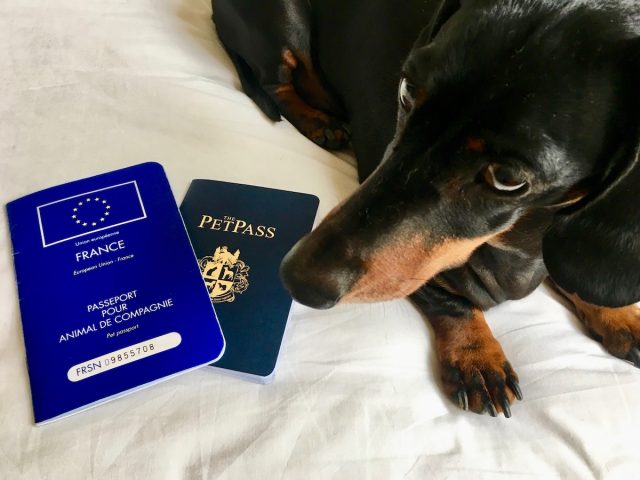
Finding a Pet-Friendly Airline to Fly to Europe
The next important step is finding a pet-friendly airline to fly yourself and your dog to Europe. Unfortunately, some airlines that normally allow pets to fly in cabin, don’t allow this on Transatlantic flights, in particular American airlines .
Flying with a US Airline
If you are wanting to fly with your dog in the cabin, not all American airlines permit this on Transatlantic flights. American Airlines clearly states in their pet policy that they don’t allow pets in the cabin on Transatlantic flights, due to the flight duration.
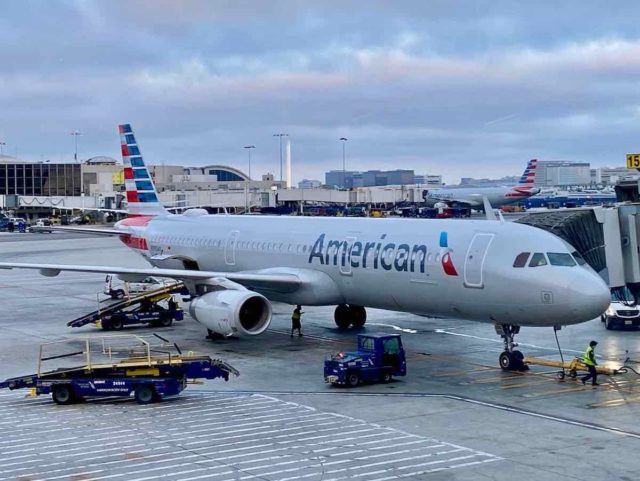
One American airline that definitely allows pets in the cabin on flights to Europe is Delta . For pets in the cabin, there is no maximum weight, just a maximum kennel size that depends on the flight (check at the time of booking). A charge of $200 USD applies and a maximum of four pets are allowed in the cabin. Read their pet policy .

For awhile, United Airlines also didn’t allow pets in the cabin on Transatlantic flights, but they are once again allowing pets on flights to Europe, except to Ireland, Sweden and the UK. If you fly with your pet in the cabin with United Airlines, a charge of $150 USD applies. There’s no maximum weight, just a maximum kennel size. See their full pet policy for in-cabin pets .
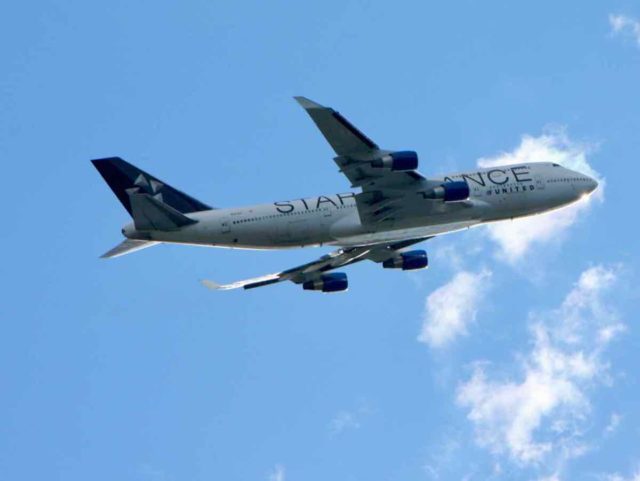
If your pet is too large to fly in the cabin, there are currently limited options for pets to fly in the hold on US airlines. Only American Airlines accepts pet bookings through PetEmark .
Delta Cargo has not accepted bookings for pets since 2020, while United Airlines no longer accepts bookings through United PetSafe , although are some exceptions for active-duty US military and US State Department Foreign Service personnel travelling on official orders.
Another alternative is to fly with Air Canada . Air Canada permits pets in the cabin on flights to and from Europe, with no maximum weight, just a maximum kennel size. See their pet policy .
Additionally, Air Canada is one of the few airlines that accept pets in the cabin and as checked baggage on flights out of the UK, instead of only as cargo, as is the case with Delta. (Although pets still need to fly as cargo on flights to the UK.)
Flying with a European Flag-Carrier Airline
In general, the European flag-carrier airlines are most likely to allow your pet to fly in the cabin with you to Europe. Based on discussions with other travellers flying from the USA to Europe with their dog, the most commonly recommended airlines are Air France, KLM and Lufthansa.
All three airlines allow dogs to fly both in the cabin and in the hold on their Transatlantic flights. Here are some details about each airline.

Air France: Dogs up to a maximum weight of 8kg (17lb), including carrier, are permitted in the cabin, with a fee equivalent to €200 (about $220 USD) charged. Note that pets are not permitted in business class on intercontinental flights. Dogs up to 75kg (165.3lb) are permitted in the hold, with a fee equivalent to €400 (about $440 USD) charged. It’s possible to buy travel containers for the cabin and hold directly off Air France for delivery to the USA. Read their full pet policy .
KLM: KLM also has a maximum weight of 8kg (17.6lb) for pets in the cabin and 75kg (165.3lb) for pets in the hold, including their carrier or crate. The charge for each pet depends on your departure and destination airport. Once again, pets are not permitted in business class on intercontinental flights, due to the seat design. Read their pet policy .
Lufthansa: Lufthansa also has a weight limited of 8kg (17.6lb) including carrier for pets in the cabin. For transport in the cabin, a fee of €100 ($110 USD) is charged to/from the East Coast, €110 USD ($120 USD) to/from the West Coast. Prices for pets in the hold depend on the crate size. Read their pet policy .
For information on the pet policies of more European airlines, check out my extensive guide, which details which European airlines allow pets in the cabin .
Flying with a European Business Class Airline
A recent addition to the list of dog-friendly airlines flying between the the USA and Europe, is business-class only airline, La Compagnie . This France-based airline offers up to two flights daily between New York and Paris, plus seasonal flights to Nice – perfect for flying a dog to France from the USA . Perks include full-flat seats (although read on…), complimentary high-speed wi-fi and fine cuisine.

The biggest advantage of booking your pet to fly on La Compagnie is that dogs and cats up to 33lbs (15kg) are allowed to fly with you in the cabin, far higher than the normal limits. They need to fly in an aerated pet carrier, with maximum dimensions of 21 ⅔ in x /13 ¾ in x / 9 ⅚ in (55 x 35 x 25 cm).
There’s a limit of one pet per passenger, with a maximum of three pets permitted on each flight. You’ll need to book your pet at least 48 hours in advance (online or via the call centre) and pay a fee equivalent to 10% of your own ticket.
The only downside? If flying with a pet, you can’t fully recline your seat. Plus they count as your item of cabin luggage, so you’ll only be able to bring a small personal item in addition into the cabin.
Flying with a European Budget Airline
Unfortunately, not many of the budget European airlines permit dogs to fly on Transatlantic flights, even if they permit dogs to fly on their flights within Europe. I found this to be problematic when I was flying one-way from Europe to the USA with my dog, and the flag-carrier airlines were mainly charging astronomical prices for one-way flights.
The main option I uncovered was XL Airways, a small airline that operated out of Paris, flying to and from New York, Miami, Los Angeles and San Francisco. However, XL Airways has now ceased operations, so there’s no budget airline options that I’m aware of.
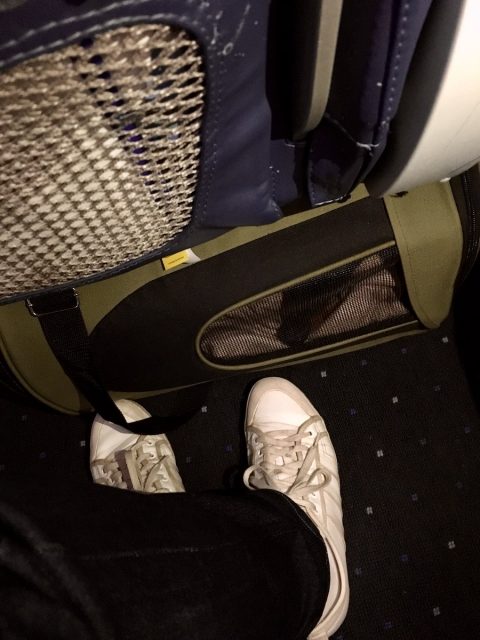
Try to Minimise the Flight Duration
Another consideration to keep in mind is the length of a flight. When I last flew from Europe to the USA with my dog, I purposely organised my travels to fly from Paris to New York, to minimise the flight duration. This is especially important if you want to fly with your pet in the cabin.
In order to keep your flight duration to a minimum, consider taking a connecting flight on either end. For example, firstly fly from the West Coast to the East Coast, before flying on to Europe. Also consider taking a second flight within Europe to get to your final destination. This is also an option if you don’t find a pet-friendly airline that flies directly to your final destination.
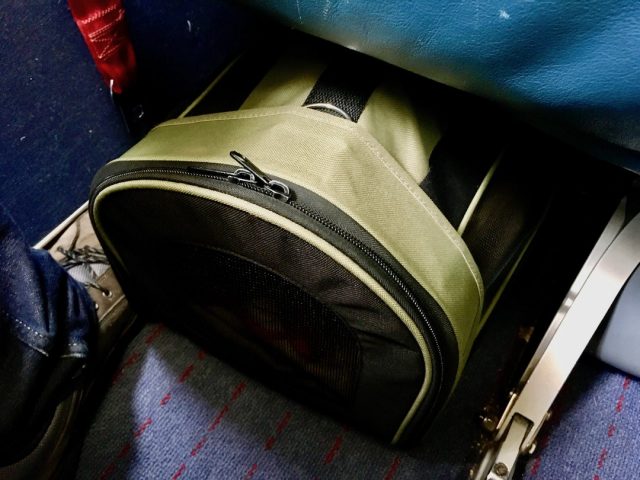
Choose the Time of Day Carefully
If flying with your animal in the hold to Europe during the summer months, keep in mind temperature restrictions may apply. Perhaps consider taking an overnight flight that departs late in the day then arrives early in the morning in Europe. Read more of my tips for flying with a dog in summer .
What About Emotional Support Animals?
There are now limited options to fly in the cabin of a plane with your dog as an emotional support animal. Generally your pet will now need to fly as a pet, either in the cabin if they are less than the weight limit (if applicable) or in the hold, and pay the appropriate fees.
Some European airlines previously allowed emotional support animals to travel in the cabin on flights to and from the USA, but not always on other flights in Europe. However, these policies have generally also disappeared.
Prefer to cruise rather than fly? Find out more about the kennels aboard the Queen Mary 2 Transatlantic Crossings
Preparing Your Dog for Their Flight to Europe
Preparing your pet for a long flight to Europe can be daunting, even if you have previously flown with your pet. Based on my experience flying with my dog multiple times on long flights, these are my tips:
- Adjust your pet’s meal times if required, feeding them at least a few hours before the flight, not immediately before it, in case of an upset stomach. Don’t give them too much to drink either.
- Take your dog to a pet relief area as close to the flight as possible, either immediately before boarding or before going through security. This is especially problematic at European airports which tend not to have designated pet relief areas. Generally you need to take your pet outside the terminal building to some grass.
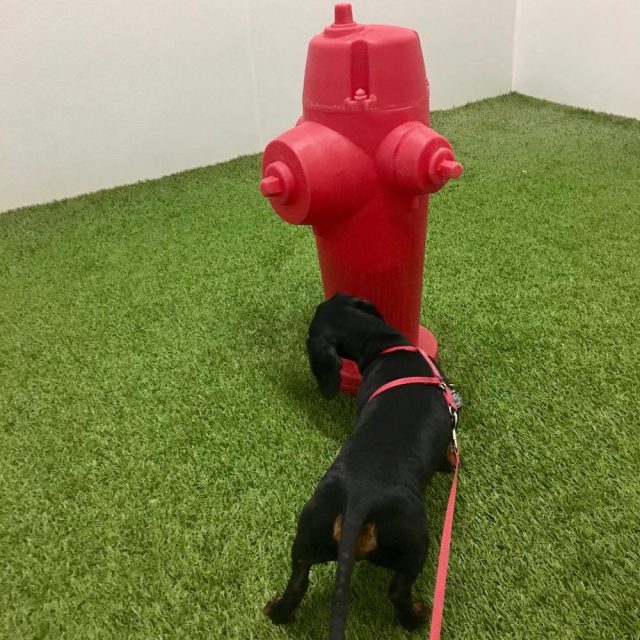
- This is a little easier to handle if your dog has been trained to use puppy pads. Some other travellers travelling with a pet in the cabin report using the plane’s bathroom to give their dog a break mid-flight. My dog isn’t trained at this (although is fine to hold on for 8 hours, if given minimal fluids), plus those bathrooms are tiny!
- On the flight, dogs travelling in the hold should have a water container attached to their crate. In the cabin, feel free to give your dog some fluids, but don’t give them too much. Some other travellers use ice cubes.
- Get your dog used to their crate or carrier ahead of time, regardless of whether they are travelling in the cabin or hold. Hopefully your dog just falls asleep and sleeps for most of the flight. To aid with this, either give them a big walk beforehand or fly overnight, when they’d normally be sleeping.
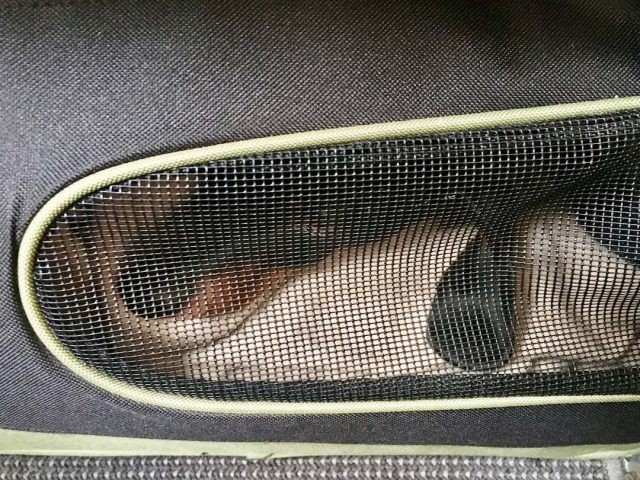
- If your dog is travelling in the hold, sedation is not usually recommended. (Sedatives can affect your dog differently at altitude, plus there is no-one to assist if something goes wrong.) If you are concerned, speak to your veterinarian ahead of time, allowing time to test treatments. Most dogs cope better than you expect.
See also my guide to flying with your dog in the cabin in Europe and my tips for flying with a dog .
Returning to the USA with Your Dog
The steps to return to the USA with your dog depend on whether or not your dog has visited any high-risk countries for rabies.
For the majority of European countries, that are listed as low-risk or rabies-free, you will need to complete a CDC Dog Import Form. This can even be completed up to six months in advance, even before leaving the USA.
All dogs entering the USA also need to appear healthy, have a microchip (which is also required for visiting Europe) and be at least six months old.
If your dog has visited any high-risk countries in Europe or elsewhere, more onerous conditions apply, especially if your US rabies vaccine has expired. For full details, see this post .

The European countries that are listed as high-risk for rabies by the CDC are: Armenia, Azerbaijan, Belarus, Georgia, Moldova, Russia, Turkey and Ukraine. See the latest list . Note that is different to the list used by the EU.
Also double check if there are any state specific requirements (see above for more details) or you airline has their own requirements. This may include a health certificate or “fit to fly certificate” and a rabies certificate (required by United Airlines for international flights).

Returning from Italy
While most European countries don’t have any requirements for pets being exported out of the country, one exception is Italy. Pets flying out of Italy to countries outside of the EU, including to the USA, require a Pet Export Certificate.

You will need to visit a local veterinarian to obtain a certificate of good health, then within 48 hours visit the local ASL (Azienda Sanitaria Locale), who will check your pet’s health and rabies certificates and issue an export certificate, for a small fee. For full details, see this US embassy website .
You May Also Like
- How to Travel with a Dog to the UK from Outside Europe
- How Dog-Friendly Are Airports in Europe?
- Travelling with a Dog in Europe
About the Author

Shandos Cleaver is the founder of Travelnuity: Dog-Friendly Travel. She has travelled extensively with her Miniature Dachshund, Schnitzel, including to 33 countries across Europe, every state and territory of Australia except Tasmania, and 10 of the United States. She’s passionate about providing inspiration and information to others wanting to travel with their dogs, whether close to home or internationally.
Inspired? Pin this to your Pinterest board!
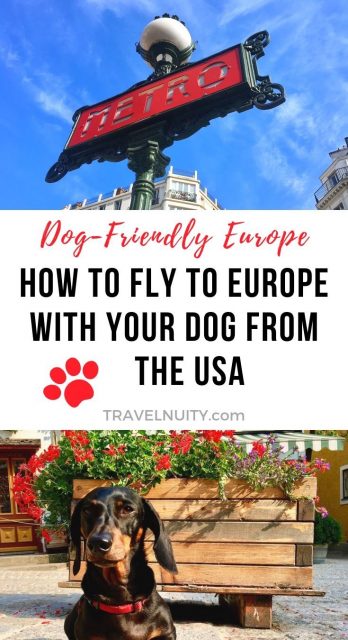
41 thoughts on “Flying to Europe with a Dog from the USA”
Excellent breakdown here. More folks fly with their pooches these days.
Thanks Ryan!
I heard airlines weren’t allowing dogs and cats on intercontinental flights anymore. Guess the rules have changed again. I think they banned all other support animals, which is good!!
Nice breakout! We’re moving to England with our pup and have completed most of these steps. Now to just make it through customs…
All the best with your move! Customs in Europe is usually fairly easy, but the UK checks are strict!
Thanks!!What about ? cat!? I am not sure is same traveling with cat ! I will be traveling with my cat at spring from Austin, TX to Zagreb Croatia! What l need to do here before travel.thanks!
Zee – Most of the same regulations apply for both cats and dogs. (Rules for more exotic pets vary by airline.) The main difference is that cats don’t require the worming that some dogs requires for countries like the UK. Enjoy your trip!
How did your trip turn out?? I plan to do the same trip to Zagreb.
We traveled to Europe for a month leaving our Irish setter, Snacks Mc Reilly, at our trainer’s pet lodge. He was less traumatized than we were. We are almost 70, yet dream of returning to Europe one more time. We continue to think about the Pilgrimage to Santiago. How beautiful to imagine walking the Camino with Snacks! The reality is, we live in Spokane, Washington, the Pacific Northwest. We are thinking the flights there and back would be both unusual and cruel. Shared thoughts and experiences would be most welcome, informing us of the truth, either way.
It would be amazing to walk the camino with your dog, but it’s not an easy decision to put them into the hold. For a long flight like that (or two flights), I would probably hold off unless you’re going to be in Europe for quite a while (longer than a month). Though it also depends on the age of your dog and whether they’ve flown before and how they’ve handled it.
Thanks for all the tips. However, american airlines does allow pets on flights to europe, not sure if they might have changed their policies since this was written.
Thanks Melinda! I will go over this and review the options, once the current travel lockdowns are over. A number of the US airlines have restrictions but have changed them multiple times, so it’s hard to keep up.
That’s what I’m wondering!! I heard recently, they weren’t allowing dogs, I guess that includes cats on international flights and had banned all other crazy animals in the USA.
I am getting ready to move from the USA to Italy for four years. I am taking my almost three year old; 125 pound Great Dane with me. He has never flown before. Any tips from seasoned fliers that have traveled with large dogs before? Thank you
I don’t have personal experience, so I recommend asking in my Facebook group: https://www.facebook.com/groups/dogfriendlytravelrtw . You may run into issues with maximum weights/sizes for dogs and their crates on some airlines, especially flying as checked baggage rather than cargo. To determine the size crate required, see: https://www.iata.org/en/programs/cargo/live-animals/pets/
I just completed a round-trip from the west coast USA to Athens, with a stop in Frankfurt. This blog and the reader comments helped me immensely, so I wanted to share my experience with others.
We flew Lufthansa with our 4kg dog in the cabin. We did not feed her any breakfast the morning of our departure, but took her out for a walk and pee as usual. Check-in was easy and quick with the USDA signed health certificate and rabies vaccination certificate. No one measured our travel crate at check-in, nor did they weigh it or our dog. Our flight + wait around to board time was 13 hours from SFO to Frankfurt. On the flight, I gave our dog a 1/2 a Trazadone and offered her tiny sips of water, which she refused to drink. Upon landing for our connection, we had a 2.5 hour layover. Not enough time to leave the airport and return because the security line at customs was backed up. Our dog would not go pee on the marble floor of the airport. We boarded our flight from Frankfurt to Athens, and I gave her another 1/2 Trazadone and offered her water, which she accepted. I took out a pee pad and placed it at my feet on this flight, and snuck her out of her carrier and gave her the “go pee” command. She refused. So, back in the carrier she went for the rest of the flight, and I took her outside as soon as we landed and collected our luggage. She finally peed, after a full 19 hours of travel. (There is a green grassy area just in front of the Sofitel at the arrivals exit door in Athens.) During both flights, I kept her on my lap in her carrier and pet her the whole time. They flight attendants were strict about my keeping her in her carrier- but I snuck her out when they darkened the cabin and she slept under a blanket on my lap for about 3 or 4 hours of the journey. The same thing took place on our return home other than (a) they weighed our dog and carrier upon check-in and (b) the USDA agent asked to see her rabies certificate as we exited the airport in our home town. Yes, our dog once again held her pee and poop for 19 hours! Overall, flying with her was MUCH easier than I expected, and the paperwork/verification was a breeze.
That’s great to hear, thanks for sharing! It’s surprising how long they can hold on, if there’s no grass to go on.
Hi Anne, how were you able to get the USDA Health Certificate? Were you able to do it online or you had to go to an APHIS office to get it? Headed to France in November, your comment has been very helpful!
This is a solid article. Thank you so much for putting it together. We are putting our place on the market and just going to travel Europe with pups in tow. 🙂
Thanks Uric, wishing you lots of fun!
Great article! My boyfriend and I have 2 golden retrievers, we don’t want to feel confined to road trips, thinking of Italy sometime this coming year…
Thanks Josselyn, enjoy planning your trip!
Great article! We also have a long-haired miniature dachshund. He’s one year old and has traveled with us in cabin inside the USA. We are now preparing for a trip with him to Italy. Before departing overseas, we are stopping to visit family in various US states. Can we get the USDA vet visit and certification done in one US state but then fly out of a different state?
I’m pretty certain that’s allowed, as some states don’t have a USDA office and many people take a domestic flight before an international flight. If you have any doubts, check with the USDA beforehand.
Hey Shandos,
thanks for the reply. The USDA was very informative and the answer is yes, you can get the certificate in one state and fly out of anywhere in the USA. Another question. In Italy were you able to get a Pet European Passport without being resident? From all i’m reading you have to be a resident.
I’ve recently had a comment left from someone who was also told that. Previously you didn’t need to be a resident, but since Brexit and an influx of Brits trying to get EU pet passports, some countries have cracked down on the rules (France and now Italy). It’s still worthwhile trying.
Hi! Thanks for all the info. If I fly into Spain with all my proper documentation, will I be able to then fly to Italy & spend 10 days with my dog there before returning to Spain? I think the answer is yes but thought asking you might be a good idea. Thanks!
Yes, that will be fine, assuming it’s within 4 months of you arriving in Spain. Just ask the customs official in Spain to stamp your dog’s paperwork when you arrive.
we just found out that KLm does not allow hold pets on their 787-9 or 787-10 planes any recommendation, we bought a small home in Holland and had planned to take our dog with us when we spend 4-5 months of the year there. have any info on cargo flights for dogs ?
I’m not fully across the airlines that allow dogs to fly in cargo across the Atlantic. I believe some of the US airlines don’t allow pets in cargo at the moment, but I recommend checking with other European airlines, such as Lufthansa. The downside will be a possible transit stop.
I just wanted to thank you so much for this information! It saved me days of research and trial and error. Thank you for all your work.
Glad I could help! I remember how little I knew before I first flew internationally with my dog.
Thank you so much, this is very very helpful! I am at my wits end trying to get my dog the EU passport. I have done the USDA certification for Italy a few times now and it is such a hassle with the 10 day limit for Italy and the costs. I’m hoping the EU passport alleviates these issues. However, the vets in Italy at the Azienda Sanitaria Locale say they won’t issue one if my dog has a US microchip. Is this true? Do you know any other way to get the EU passport?
My dog got issued one in France, but this was prior to Brexit when French vets started restricting issuing them unless you had residency. I wasn’t sure if vets in Italy were okay issuing them – can they actually tell the microchip is from the US? I wasn’t aware of that. Perhaps try a different vet in Italy? I’ve heard recent stories of Spanish vets issuing them, plus German vets tend to be okay, except they usually insist on a new rabies vaccine.
Thanks Shandos, I’ll share here if I find any useful information! Really appreciate you and your site and helpfulness 🙂
I am planning to flying from NYC in January 2024 to Portugal with my dog in Cargo. I will be spending at least a month in Southern Portugal. in the Algarve, then flying back to NYC in February. I read that I may not be able to fly with my dog at all during this time of year. Is this true?
Some airlines have restrictions on flying with dogs during the hot summer months, or when it’s very cold. However, I haven’t heard about it applying in New York City. This is airline dependent, so I recommend asking the airline.
Thank you so much for this article. I need to go to the UK for 3 months for work. We need to take our small dog. We can’t fly our dog in the cabin to the UK. I was advised to fly to Paris, France, with our dog in the cabin. Do we need health certificates for the EU and UK? Can we take a train to the UK if we fly to Paris? How long is our certificate good for in the UK if we can’t get an EU passport in France? All of this is so confusing. Do you recommend another way? Any insight you can offer would be greatly appreciated. Thank you!
Yes, you’ll need health certificates for both the EU and the UK. You won’t be able to take the train to the UK (no dogs on the Eurostar across the channel) – instead it’s easiest to take a pet taxi that goes on the Channel Tunnel, or there are a few pet-friendly ferries (Dieppe to Newhaven, Hook of Holland to Harwich, Amsterdam to Newcastle). Once you are in the UK, there is no issue with expiry date of the certificate, as long as you stay in the UK. You may need new certificates for the return trip, depending on what route you take.
Two other options to consider, in addition to flying to Paris, is to fly to Amsterdam (particularly if you want to take one of the ferries from the Netherlands) or to fly to Dublin, although not as many airlines fly to Dublin with pets in the cabin. However, from Dublin there’s plenty of dog-friendly ferries across to Wales, then the trains in the UK are pet-friendly.
Shandos thank you for all the great info. I am in the US and would like to travel around Europe for a few months with my wee Westie. If I rent/lease a car what should I expect when entering a country with my pup by vehicle? Thanks!
If you’re driving between countries in the Schengen zone, don’t expect any checks at the border, either on your own passport or your dog’s paperwork. However, do check in advance with your rental company which countries you can drive in (particularly in the east where not all countries are in the EU there may be restrictions). Plus, many countries have a “vignette” sticker to drive on the motorways, so check what’s on the car and whether you need to buy one for cross-border excursions. Your rental car company should be able to help you out.

Leave a Comment Cancel reply
Save my name, email, and website in this browser for the next time I comment.
I took my dog to Barcelona to get an EU pet passport: Here's what I learned
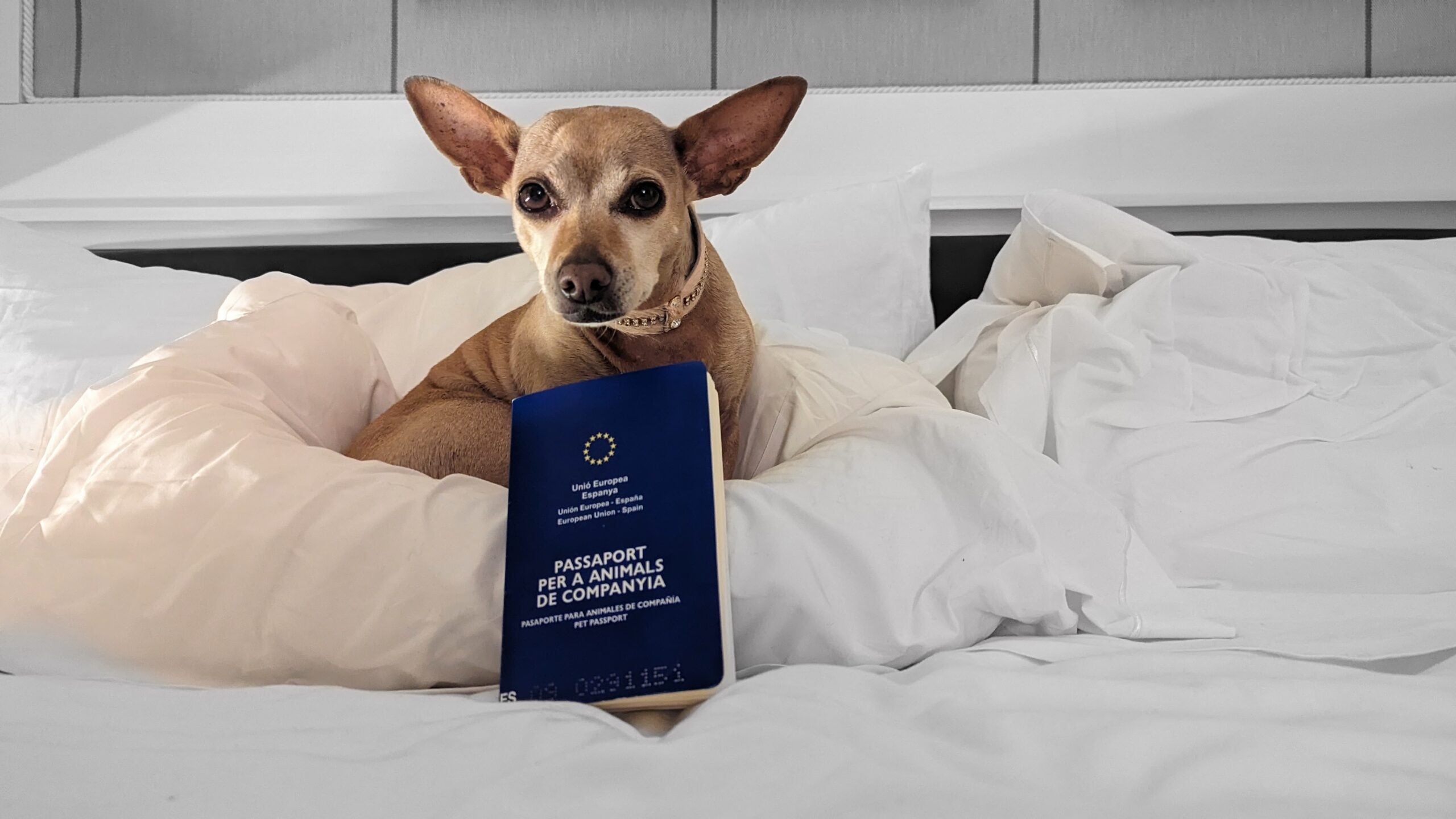
In 2023, my dog Poppy flew United Airlines 37 times, vacationed in Aruba and Mexico , and, most exciting of all, got her European Union pet passport in Barcelona.
Poppy, who is trained to assist me with a psychiatric disability, flies free as my service animal . However, we were spending a small fortune each year on international health certificates (around $300 per certificate) required each time an American dog enters any country other than Mexico and Canada.
Having an EU pet passport eliminates this step and allows Poppy to travel freely to EU countries — as well as Switzerland, Norway and much of the Balkans — for the next three years. This is a great cost-cutting measure for travelers who frequently visit Europe with a pet.
Getting an EU passport for Poppy in Spain was much easier than I expected. As I learned, Barcelona is the perfect destination to go through the process.
Pups are everywhere in this city, and it's hard to walk for more than a minute without your doggo sharing sniffs with another canine. There are also fantastic dog-friendly hotels , restaurants, Europe's only dog water park, beaches and even some attractions you can visit with your fur child.
Here's everything you need to know about the EU pet passport process. Note this article pertains to American dogs traveling to and from the EU. Every country has different entry requirements. So, if your dog doesn't live in the U.S., you'll need to check with your home country about the requirements if you plan to travel back and forth.
What is an EU pet passport?
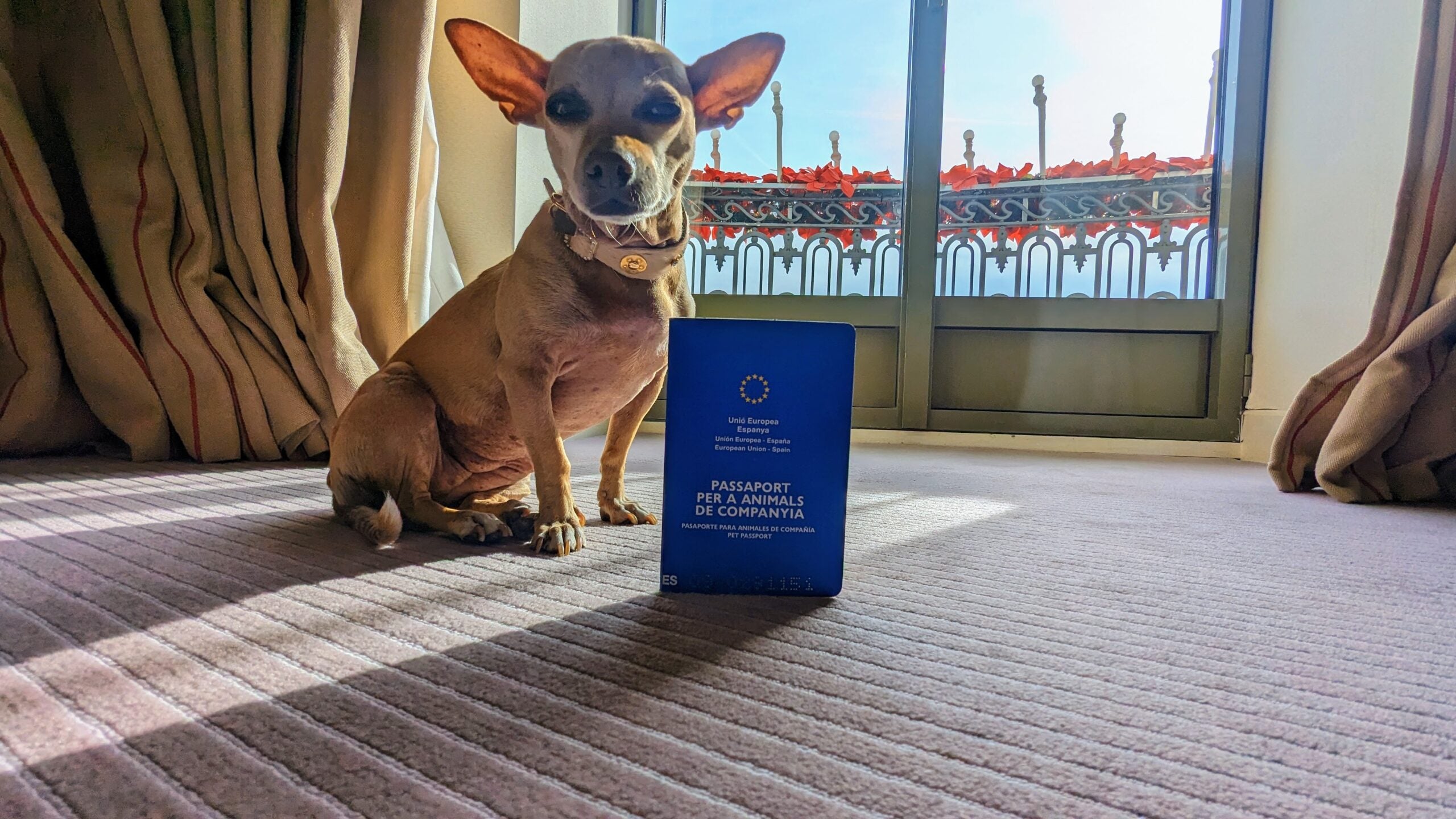
An EU Pet Passport is a document issued by an official veterinarian in a country within the EU that contains health information related to a specific pet. It cannot be obtained in the U.S. The passport is a blue booklet that resembles a human EU passport and even has space for a photo of your pup (though this is not mandatory).
What is mandatory is that your dog be revaccinated for rabies by the EU veterinarian that issues the passport. So, you must take your dog to Europe to get vaccinated. The trickiest part of this process is that your dog must be vaccinated against rabies twice if you are traveling to Europe and not moving there. This is because to return to the U.S., you will need a valid rabies certificate issued by an accredited American veterinarian. Think of it this way: A rabies vaccine basically serves as your pup's passport, so they will be dual citizens.
"Luckily, there are no proven negative effects of double vaccinating a dog against rabies, so long as the vaccines are not given within a few months of each other," Poppy's veterinarian, Dr. Bethany Yurek, who practices in Colorado, told me. Poppy's vaccines are spread out 1.5 years apart, which resulted from lucky timing, but if the vaccines are given about six months apart, you should be good to go.
Of course, it is always best to consult your veterinarian before deciding to revaccinate before expiration. You will also want to request three-year rabies vaccines.
Why get an EU pet passport?
If you plan to travel to Europe multiple times over three years (the length of the longest rabies vaccine), an EU pet passport will save you thousands of dollars and a lot of time.
Without one, you will have to take your dog to its veterinarian to get an EU international health certificate issued and then endorsed by a vet at the U.S. Department of Agriculture. The entire process must be done within 10 days of entering the EU, and it'll cost around $300.
You can use your health certificate to enter multiple EU countries for up to three months on a single visit, but you cannot use the health certificate for a second visit later. So, even though I got a health certificate when I took Poppy to Italy previously, it was not valid for this trip to Spain.
Obtaining an EU pet passport (besides being adorable looking) allows you to travel back and forth to EU countries, Switzerland, Norway and much of the Balkans without any other paperwork for as long as the EU-issued rabies vaccine is valid.
To maintain your dog's EU passport, you must schedule their next rabies vaccine in Europe before it expires.
Can dogs living outside the EU get the pet passport?
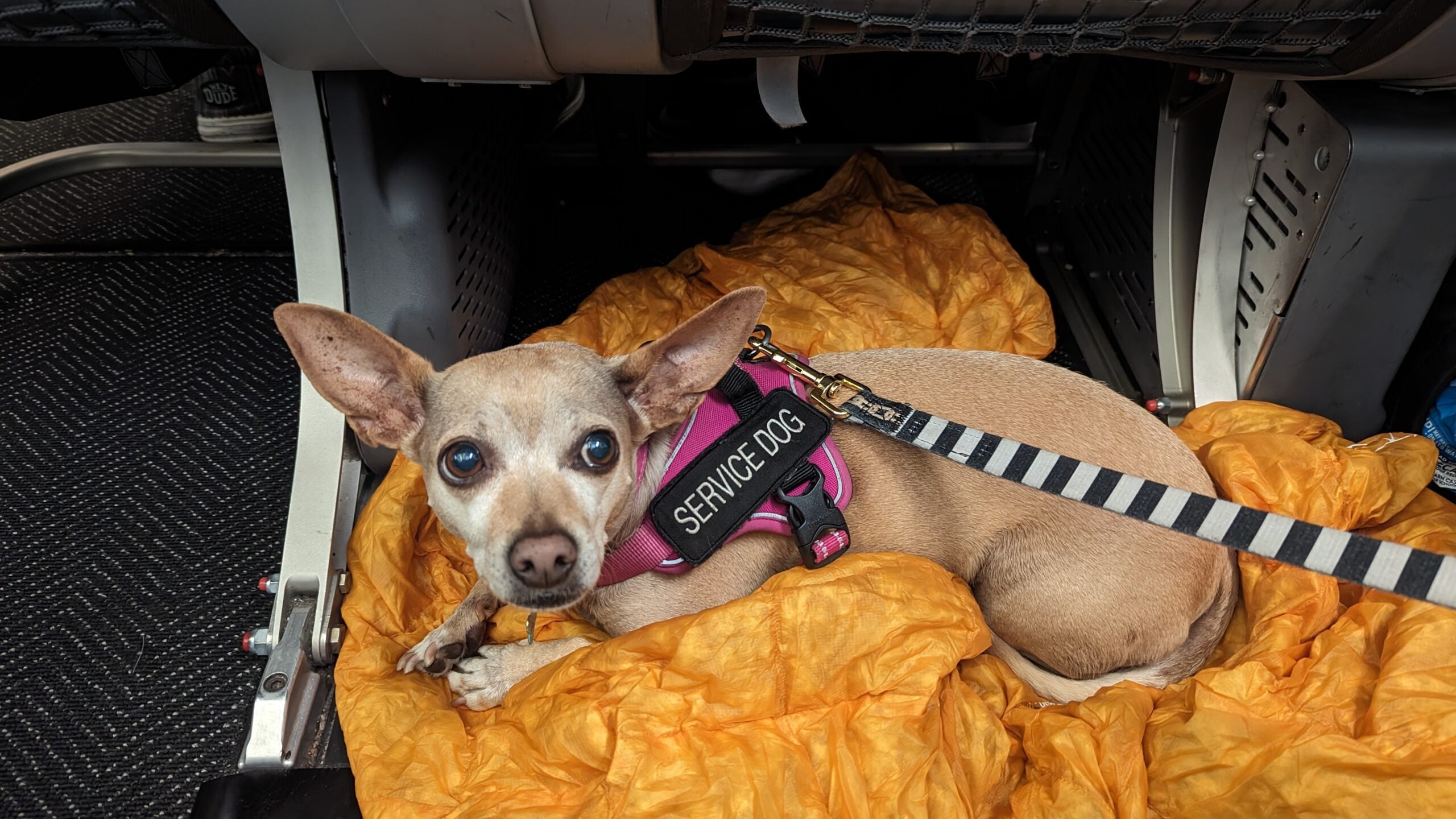
Yes. "The purpose of the EU Pet Passport is to simplify travel between EU Member States, but the EU has also allowed it to be used for pets returning to the EU from other countries as long as it is a non-commercial movement," according to the USDA. Noncommercial movement means you are not importing more than five animals to sell them. The passport is designed for pets only.
What is the process for getting an EU pet passport?
Getting an EU pet passport was a lot easier than I expected. I used TomVets in Barcelona; I found the company by quickly searching Google for vets with good reviews issuing EU pet passports to visitors. I reached out via WhatsApp and received a response in English within a day.
Dr. Tommaso Piermarini makes home vet visits. He came directly to the Majestic Hotel & Spa , where we were staying, to administer the rabies vaccine and issue the passport. It was so convenient that it immediately brought my stress levels down. I filled out some quick paperwork online before the visit, and that was it.
On the appointment day, Dr. Tommaso showed up promptly and spoke fluent English. We went to my room, and the process took less than 30 minutes. When he left, Poppy had a shiny new passport. The cost was also very reasonable at 155 euros ($167).
Barcelona is ideal for a Spanish citizenship vacation

Besides the ease of getting the EU pet passport here with a mobile veterinary service like TomVets, Barcelona is a fantastic doggy vacation destination. In addition to its Mediterranean climate, great food and beautiful beaches, the city welcomes pups with exuberance.
I stayed at the Majestic Hotel & Spa , an elegant neoclassical property on the city's famous shopping street, Passeig de Gracia, in the trendy Eixample neighborhood. Welcoming guests since 1918, it's the city's most famed luxury hotel.
The Majestic welcomes small canine guests with its Very Important Pet package ; the package includes a personalized welcome card, toys, treats, bottled water, a comfortable bed, food and water bowls to use during your stay. Dogs must weigh about 20 pounds or less — the same size pup that can travel as a pet in airplane cabins.
The hotel has various accommodation options, but in honor of Poppy's Spanish citizenship milestone, we stayed in one of the Majestic Suites. The massive room featured multiple balconies offering jaw-dropping, panoramic city views; a separate bedroom and living space; a giant walk-in closet; and a marble bathroom.
Don't skip sunset drinks and a bite to eat at the Majestic's rooftop terrace bar — where you can, of course, bring your pup. The 360-degree views of the city serve as the perfect backdrop for a photo sesh with your best friend. The sunsets seem to go on forever with an everchanging display of vibrant colors.
The hotel also has a fantastic spa, and I got rid of my jet lag with a luxe two-hour body and facial treatment.
Dog-friendly attractions and restaurants

Across the street from the Majestic is Casa Batllo . Considered one of Spanish architect Antoni Gaudi's greatest masterpieces, it was created in the early 1900s for a wealthy family. Nowadays, it is an immersive architectural museum experience and one of the few attractions of its kind that welcomes dogs. Poppy swapped tea with more than one canine visitor while I got lost in its trippy light shows, shimmering tile facade, undulating curves and other swirling shapes. If you visit during summer, Casa Batllo often has live music and drinks on its roof terrace.
The Majestic's central location makes it easy to access some of Barcelona's best neighborhoods for walking. The Gothic Quarter and the Born are within a 30-minute walk of the hotel. Most shops in Barcelona allow dogs, and many restaurants also welcome pets on their patios. Some places — like La Carioca , which serves Brazilian-inspired food and drinks — even include pups inside.
Related: 10 best dog-friendly destinations to explore this summer
Barcelona is also home to Europe's first water park for dogs. AquaPark Canino is a must for pups who like to swim. The park, open from June through September, has two large swimming pools, a dune area for rolling, gardens for frisbee or ball-catching sessions, and even a restaurant where you and your pup can dine.
In winter, you can walk your dog along Barcelona's beachfront and miles of gold sand. However, in summer, you'll need to stick to Llevant Beach, Playa de Les Salines and Cala Vallcarca, which are dog-friendly.
The city also has several dog-friendly parks and gardens, including most parts of Park Guell , another Gaudi-designed masterpiece. Parc de la Ciutadella, Parc del Clot, Parc de la Barceloneta and Joan Miro Park also welcome woofers.
Finally, if your pup likes to shop, you must head to Barcelona Dogs in the Born. The shop carries one-of-a-kind designer collars and matching leashes as well as harnesses and coats for dogs and cats. Poppy chose a beautiful pink suede collar adorned with filigree crystals to celebrate her Spanish citizenship.
Related reading:
- Key travel tips you need to know — whether you're a beginner or expert traveler
- The best travel credit cards
- Where to go in 2024: The 16 best places to travel
- 6 real-life strategies you can use when your flight is canceled or delayed
- 8 of the best credit cards for general travel purchases
- 13 must-have items the TPG team can't travel without
An official website of the United States government
Official websites use .gov A .gov website belongs to an official government organization in the United States.
Secure .gov websites use HTTPS A lock ( Lock A locked padlock ) or https:// means you’ve safely connected to the .gov website. Share sensitive information only on official, secure websites.
The following are answers to frequently asked questions (FAQs) from pandemic coordinators regarding contact tracing, quarantine, and travel. This document will be updated as new information or new questions are received. For more detailed guidance, please review the USDA Workplace Safety Plan (PDF, 568 KB). Please also check the FAQs from the Safer Federal Workforce which includes information about the topics included here, along with others.
- Is there guidance on quarantine practices after travel to high-risk areas. What are the obligations of travelers to self-quarantine?
USDA employees should adhere strictly to CDC guidelines before, during, and after travel , regardless of whether the travel is personal or for official business. If quarantine is required because of official travel or workplace exposure, agencies will provide weather and safety leave, or other administrative leave. If quarantine is required because of personal travel, and the employee is otherwise expected to be present onsite, the employee may take personal leave while quarantining. Please refer to the Safer Federal Workforce for more information on quarantine and travel.
- If an employee tests positive for COVID, what are their obligations to report this to their managers and/or self-isolate?
Any individual with a suspected or confirmed case of COVID-19 will be advised to isolate by their supervisor, pursuant to CDC guidelines, and in compliance with local laws/regulations. Personnel who have had a close contact ( as defined by the CDC ) with someone who has COVID-19 should follow CDC and local guidance for quarantine. Employees who remain on enhanced telework status may choose to voluntarily disclose their positive COVID-19 result to their supervisor. Employees who have physically returned to their duty station must report a subsequent positive test result to their supervisor. All positive COVID-19 cases reported must be entered into the Department’s Sharepoint Tracker tool which is accessible by employees.
- Are employees obligated to notify managers of travel to COVID high-risk areas in advance?
Employees who perform mission critical work that cannot be performed remotely must factor quarantine requirements into their leave requests for personal travel. Please refer to USDA Workplace Safety Plan (PDF, 568 KB) for more detail about travel and quarantine.

An official website of the United States government
Here’s how you know
Official websites use .gov A .gov website belongs to an official government organization in the United States.
Secure .gov websites use HTTPS A lock ( Lock A locked padlock ) or https:// means you’ve safely connected to the .gov website. Share sensitive information only on official, secure websites.
Vilsack Travels to Europe Next Week to Discuss Expanding Trade Opportunities
Contact: Office of Communications, (202) 720-4623
WASHINGTON, June 13 – Agriculture Secretary Tom Vilsack will travel to Europe next week to meet with agricultural and trade officials and stakeholders to discuss the expansion of agricultural trade, the importance of agriculture’s role in the U.S.-European Union (EU) Transatlantic Trade and Investment Partnership (T-TIP), and the benefits the trade agreement will have to both the American and European economies. The Secretary’s trip will include meetings and site visits in Brussels, Luxembourg City, Paris and Dublin.
“The EU is the world’s largest importer of food and agricultural products,” said Vilsack. “But despite the continued growth of this market, U.S. market share is shrinking because U.S. producers and exporters continue to face numerous trade barriers. The negotiation of the T-TIP offers a major opportunity to address these barriers and expand market access for U.S. farmers and ranchers.”
Since 2009, nearly one-third of U.S. economic growth has been due to exports. America has seen record agricultural exports over the past five years, which has been critical to creating jobs in rural America and helping our country’s economy recover. Agricultural exports alone reached a record $140.9 billion and supported nearly one million jobs in the United States last fiscal year.They are projected to reach another record of $149.5 billion in fiscal year 2014.
“The agricultural sectors in both the U.S. and the EU stand to benefit from a strong T-TIP agreement,” Vilsack said. “Reducing barriers to trade in the agreement will be especially beneficial to the small and medium-sized businesses that are the backbone of our respective economies.”
In Luxembourg City, Vilsack will address the agriculture ministers from the 28 EU member states. Vilsack will emphasize to his European counterparts the importance of agriculture leaders’ involvement in T-TIP negotiations and will urge them to share their expertise with trade negotiators to develop an ambitious T-TIP agriculture package that creates jobs and strengthens rural economies.
In Brussels, Vilsack will meet with EU Agriculture Commissioner Dacian Cioloş, EU Energy Commissioner Gunther Oettinger, and EU Parliament Agriculture Committee Chairman Paolo de Castro. He will also meet with Brussels-based U.S. business interests at the American Chamber of Commerce.
While in Paris, Vilsack will address French food and agricultural stakeholders, emphasizing that U.S. and French farmers share more commonalities than differences. He will also meet with Bernard Vallat, director of the World Animal Health Organization (OIE), and Stéphane Le Foll, France’s minister of agriculture.
Finally, Vilsack will travel to Ireland, where he will meet with Agriculture Minister Simon Coveney and accompany Coveney on a tour of Irish beef and dairy farms.
USDA is an equal opportunity provider and employer. To file a complaint of discrimination, write: USDA, Office of the Assistant Secretary for Civil Rights, Office of Adjudication, 1400 Independence Ave., SW, Washington, DC 20250-9410 or call (866) 632-9992 (Toll-free Customer Service), (800) 877-8339 (Local or Federal relay), (866) 377-8642 (Relay voice users).
Related News
Usda, ustr seek new trade advisory committee members, usda trade mission to expand ag exports in vietnam, southeast asia, usda announces december trade mission to morocco, get reports, news, and more delivered straight to your inbox.

Traveling with a Pet to Europe from USA
Last Updated on Jul 24, 2024
Wondering how to travel with your pet from USA to Europe in 2024? It may sound daunting at first, but it’s actually a pretty easy process.
If you’ve been following me on Instagram for a while you must have seen that my cat, Poofy, is a great travel cat. He travels with us on planes, goes on road trips and walks on a leash like a dog. But, we’ve only traveled with him around the US before as he was born in Colorado.
Unsurprisingly, when we moved to Europe for the first time in 2019 Poofy obviously came with us straight away, one of the most popular questions became: how did you move with a cat to Europe? We moved again in 2022 and then brought the cat back with us multiple times. In fact, he’s moving back to Europe with us again this year.
Let me tell you that if you’re comin g from the US to Europe transporting your pet couldn’t be easier. Here is how to do it.
How to Travel with a Pet from the US to Europe
Many people prefer to hire a company specializing in pet transportation, but after I saw their prices I found it ridiculous. It’s so easy to transport pets on your own and arrange all the necessary paperwork for less than $400, that there’s no point in paying someone $1000-35000 to do it for you. It feels like a robbery to me.
Unless you have some exotic pets or breeds that are banned from some airlines or have to transport over 3 pets at once, there’s no point in hiring a company to do it for you.

Where Can My Pet Travel With Me in Europe?
Most EU countries have pretty straightforward rules, except Ireland, the United Kingdom and Iceland. These countries require all pets to arrive in cargo instead of the cabin.
However, some airlines have banned 21 dogs breeds and 4 cat breeds as they’re more sensitive. If your pet is on this list below you might want to check directly to find out how to proceed.
I know that for instance, Lufthansa asks you to sign a form saying that you take full responsibility if your pet dies.
Potentially banned or problematic breeds:
- Affenpinscher
- American Bully
- American Pit Bull Terrier
- Belgian Malinois
- Boston Terrier
- Brussels Griffon
- Cavalier King Charles Spaniel
- English Toy Spaniel/Prince Charles Spaniel
- Japanese Chin/Japanese Spaniel
- Shar-Pei/Chinese Shar-Pei
- Staffordshire Bull Terrier/”Staffys”
- Tibetan Spaniel
- Exotic Shorthair

Can My Pet Travel in the Cabin with Me?
When you want to travel with your pet, the first thing you need to figure out it whether your pet will be able to travel with you in a cabin, or has to be shipped as cargo.
This depends on the airline, size, type of animal and country you’re traveling to. If you’re traveling to any of the countries from the list below (even when it’s just transit to your final destination), you can only ship your pet in cargo:
- New Zealand
- Republic of Ireland
- South Africa
- United Kingdom
- United Arab Emirates
Pick an airline accordingly, as some as more pet-friendly than others. I can only speak for Delta, LOT, ITA, KLM, and Lufthansa on long-haul flights, as I’ve flown my cat with them on several occasions, but I also heard that Turkish Airlines is great for pet travel. KLM even has a special pet terminal in Amsterdam where you can go and visit your pet traveling in cargo.
Requirements to travel in-cabin:
If your pet is small enough (under 8kg / 17 lbs) avoid cargo at all costs. I heard multiple stories from people whose pets almost got lost and whose posts did get lost.
For any other destination, especially in continental Europe, small dogs, cats, and household birds can travel in the cabin for a one-way fee, usually collected at check-in.
They require a container and officially should remain in them for the duration of the flight, but it’s not a strict rule that’s always enforced if the animal behaves and doesn’t bother other passengers.
Poofy is actually better outside of the carrier, but knows that I can pet him so he usually sleeps and chills in it.
Full Disclosure: The way your pet travels obviously depends on your pet, airline, staff and situation. If your cat is nervous, doesn’t walk on the leash, and isn’t used to people, don’t ever let him out of his container. Poofy is a bit special, unusually calm and never bothers anyone – in fact, everyone just wants to pet him.

How to Book Your Pet’s Plane ‘Ticket’?
Each airline only allows a certain amount of pets in the cabin (either 2 or 4 depending on the aircraft), so the moment you book your flight call the airline and book your pet in. The agent will ask you about the weight of your pet, his age, and the dimensions of the kennel.
You’ll be required to pay a pet fee at the airport upon check-in. For US domestic flights the fee is usually around $125 each way, including stopovers.
Internationally, if your pet travels in the cabin or kennel in cargo it’s about $200-350, BUT only if you fly directly to a country of your destination and not changing an airline (including co-shared flights). Otherwise, you will have to pay a pet fee again.
Another detail of traveling in-cabin with your pet is that pets cannot fly business or first class on some airlines. If you’re flying with a baby or toddler on top of your pet (basically what we do every single time) technically your pet cannot “sit” in the bulkhead row where the bassinet is or at an emergency exit (because nothing can stay on the ground).
However, Lufthansa moved us to bassinet seats twice automatically in their system having very surprised flight attendant, but Poofy just rode on the seat with us and the baby slept in the bassinet.
READ MORE: How to Travel with a Cat & Leash Train Your Cat

Pet Travel Requirements for International Travel : Plan at Least 30 days in Advance
There’s no quarantine for pets coming to/from the EU from/to the US, so you don’t have to worry about it. You can bring your pet home straight away.
Other rules are very straightforward: rabies vaccine, microchip, and USDA vet’s certificate.
Step 1: Microchip: 30+ Days Before Departure
Your pet must be 16 weeks old if traveling to the U.S. from other countries and must be at least 15 weeks old for European Union travel.
If your pet isn’t a microchip that will be your first step. It’s essential that the microchip is implanted before the rabies vaccine is given, so you cannot really do it all in one go. A rabies vaccine given prior to microchip insertion is invalid and your pet won’t be able to travel.
For Europe specifically, your pet must have an “ISO 11784/11785 compliant 15 digit microchip” . I’m saying officially because if you microchipped your pet before most vets will give it a pass without giving him a second microchip – we got a pass, but it’s better to be safe than sorry.
Poofy has been microchipped and vaccinated shortly after he turned 4 months old, so we didn’t have to do it again.
Step 2: Rabies Vaccine: 30 Days Before Departure
Even if your pet is entering from a “rabies-free” country (US is considered rabies-free), it will still need a rabies vaccination after microchipping. The vaccination must be done more than 21 days before entering the country.
If your pet already has a rabies vaccine that’s valid you don’t need to get it again.
Step 3: Get a Veterinary Certificate: 10 Days or Less Before Departure
You will also need to arrange a Veterinary Certificate filled by the vet who’s USDA certified. Call your vet and ask if they have anyone, and if not they’ll point you to another place.
The Veterinary Certificate must be filled in by a licensed veterinarian within 10 days of your flight out. These days it’s done entirely online by the vet and it will be overnighted to you from USDA with a stamp.
This EU Health Certificate is valid for 4 months, so you can travel within Europe freely with it.

My Experience Traveling with a Cat to Italy, France, Poland, Netherlands, Spain
Our experience of moving with a cat from the US to Italy, and then later to France, was pleasant and easier than we imagined. However, we’ve traveled with Poofy numerous times before, so we knew what to expect from the flying itself. He doesn’t mind traveling by plane and being in the car, and usually enjoys looking at his surroundings at the airport.
First trip to Europe – 2018
Basically, all we had to do was to schedule an appointment with an USDA accredited vet 10 days before departure from the US.
As we were traveling from Texas to New Hampshire and before and staying there for a week, we got an appointment in New Hampshire.
We gave the vet vaccine records and that was it. The vet had to inquire about the number of his rabies vaccinations with his old vet, but it was just a matter of a quick phone call.
Once we got his health certificate filled out it was a matter of getting the stamp from USDA. First time we did that we could have overnighted to the Albany, NY office, but as we were flying out to Milan from NYC (it was cheaper and the flight was direct) we decided to schedule an appointment and stop by on our drive.
They scheduled our appointment very easily and we spent about half an hour waiting for the paperwork to be checked and stamped. At the airport we processed the check-in and apart from paying the pet fee, no one ever asked us to show his documents. We usually book window and middle seats when we travel with Poofy, so he can enjoy some privacy, but this time we got upgraded to Delta Comfort seats and had to sit in an aisle and middle seats.
The cat didn’t seem to mind though and as usual, spread out on both of our laps and slept there for most of the flight, before crawling back to his carrier for more naps.
When we arrived in Italy, we took his carrier and just walked out. No one asked us for cat paperwork at the immigration (in fact, we went through the automated one), or when we were leaving customs.
I heard it’s a common thing that you’re never asked to show any paperwork for your furry friend in Italy, but it’s better to be on the safe side and have it ready. They do check paperwork thoroughly when leaving Italy, not entering.
When we went to Poland on this trip Poofy became a dual citizen and got his EU Pet Passport .
From US to France – 2022
Poofy has been to Europe back and forth a few times and moved to France with us as well later on. Only once we encounter issues, as the checking agent didn’t know how to process a pet fee or check his EU passport. It’s really a simple process, so don’t be scared.
Poofy has traveled around Italy, France, visited Poland, Switzerland, and Germany. After his first trip to Europe he doesn’t need a USDA certificate anymore, because…
From US to Poland – 2024
We actually had to re-do the USDA paperwork (I explained it in EU Pet Passport post). Nobody checked a single paperwork at the counter in the US or upon arrival. They saw the cat and didn’t ask a thing.

Returning from Europe to USA with your Pet
You don’t need anything to get back into the USA from Europe with your pet as long as the rabies vaccine is still valid.
At first we were told not to use our Global Entry, but the next time we were told it’s fine to use Global Entry when you re-enter with your pet.

Do you have any questions about transporting your pet to another country? Ask ahead!
Share this:
Anna Karsten is a travel blogger, journalist and psoriasis advocate. She has been traveling the world for the last 15 years - visiting over 100 countries and living on 5 continents. Anna has been featured in The New York Times, The Daily Mail, Forbes and more.
Similar Posts

What to Expect From Living in Cape Town
Last Updated on Aug 21, 2024 Why would anyone go and live in Cape Town? Simply because Cape Town…

How to Make Extra Income Easily
Last Updated on Dec 13, 2021 Everyone wants to have more money to spend on travel. But due to a…

Moving to Mexico with Kids
Last Updated on Aug 16, 2024 Moving to Mexico is a hot topic because people finally realized how great…
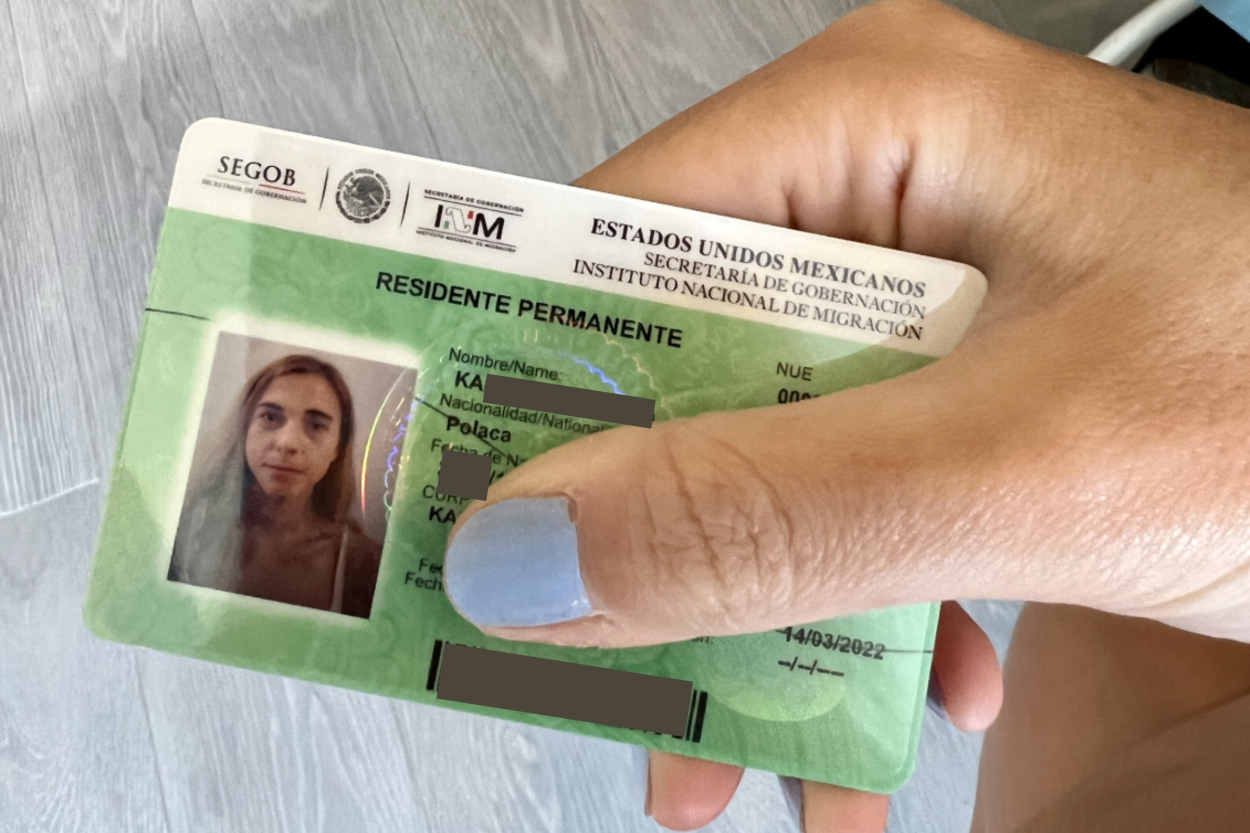
How to Get Permanent Residency in Mexico by Having a Baby (Family Unification)
Last Updated on Jul 24, 2024 Can I get Mexican citizenship through child? Yes, you can and it’s a…

EU Pet Passport: What to Know & Our Experience Getting It
Last Updated on Jul 24, 2024 EU Pet Passport is an incredibly useful document, as it lets your pet…

Tiger King British Edition – My Unshared Story About Working with Lions
Last Updated on Mar 31, 2023 During this quarantine, everyone seems to keep obsessing about The Tiger King on…
77 Comments
Such an interesting post! Thanks for sharing!
Thanks for this info! We’re planning to go on a Christmas vacation with our pets and this post really helped me. 🙂
Does it apply to all kinds of pets or only specific to some of them?
Small dogs, cats, birds and ferrets. Rabbits are slightly more difficult sadly.
Really great tips! There’s so much that goes into traveling with a pet that I never thought about.
Interesting info!
But just a heads up, the US is NOT considered rabies-free: https://www.pettravel.com/passports_rabies_free_countries.cfm , https://www.cdc.gov/importation/rabies-free-countries.html
(I know this because of an obsession with rabies I had a few years ago. I was convinced I had it after I got bit by a rat. Fun times!)
It’s treated like a rabies-free country, hence no quarantine apart from Hawaii 🙂
Thank you so much for taking the time to share your experience!
Did I miss something? Why did you guys move to Italy?
Because why not 🙂 We wanted to go to Europe for a while.
Which airline you used to fly from the US to Europe? Delta seems not to allow cats to be outside their carrier on the flight, if i read rules correctly.
Delta and Alitalia. Officially nope, but flight attendants always love him and want to see him 🙂
Hello Anna, Thank you for all these informations.. im planning to take my 10 years old cat to the states. Can you help me knowing the US rules ??
Sure, but the rules vary depending on where are you coming from.
Very helpful info on flying! I’m planning on spending 3 months in Italy with my 2 cats and I’m having the hardest time finding accommodations that will accept cats. The ones labeled as “pet friendly” seem to only allow small dogs when I look further into it. Would love to hear any advice you might have on this. Thanks!
Sadly, as you say: lots of places are very discriminatory towards cats and the pet friendly often dogs only. Call and tell them that your cats don’t scratch, that they’ve traveled before and basically convince them if they’re claiming they’re pet friendly. But Italy isn’t usually as difficult unless it’s Positano.
Hi Anna great post! Thank for all the good info. We are traveling with our dog to Bulgaria this summer and have a layover in Germany I guest i need to find out where to pay the second pet fee. He has been vaccinated for rabbles at 13 weeks old and then micro chipped at 9 months old. My question is- do we need to boost him or he is ok like that? Also the link for the USDA form is not active on the post. Thanks
How old is the dog now? There’s been a recent change and various places require yearly rabies to travel.
@Anna Karsten, sorry i forgot to mention that. he is 11 months old and the time of departure will be 1 year and 3 weeks old.
@Anna Karsten, Hi I forgot to mention that he is 11 months old and will be a little over a year at the time of travel. Thanks
Hi Anna, Thank you for your post! It removed part of the anxiety produced by leaving lady Diama in the US while we go to Europe. I have a question regarding bathroom at the plane? How do you manage? Thank you!
Most cats won’t go at all until you get to the hotel no matter what. At the airport you can set up a portable litter box (more info: https://annaeverywhere.com/how-to-travel-with-a-cat/ ) but honestly again – most cats won’t go.
Hello, I also have a dual citizenship (US and Croatian) and I am getting a ragdoll cat this month…we travel to EU every year and was just wandering if we should vaccinate our pet in EU if we get her a EU passport there? Because I don’t think US rabies vaccine is going to be valid for EU pet passport, unless endorsed. Thanks
Where are you getting a ragdoll? In the US or Europe? If you’re getting the cat in the US you will need to vaccinate your cat in the US, because otherwise she won’t be allowed to travel to the EU. If your Ragdoll is from Europe then you can do the vaccines and microchip in Europe. If you’re getting your cat in the US then you will need to get the cat’s documents endorsed by a USDA-approved vet to travel to Europe – then you can get a pet passport. According to European laws your travel cat needs to receive rabies vaccine every year now – we do some in the the US and some in Europe and it’s not an issue, but the first trip is the only tricky part.
Anna, thanks for your really helpful posting. We are from the EU and our dog has an EU Pet Passport. We are currently travelling in the US and have brought our Chihuhua, Blu, with us. I think from what you have written that when you return to the EU from the USA with an EU Pet Passport that you don’t have to provide the USDA check – have I read that correctly? Do you have to get any vet checks when returning to the EU in your experience? Unfortunately the EU sites are particularly clear on this specific point. Thanks, Adrian. P.S. We flew KLM with Blu in the cabin and the airline and staff dealt with Blu very smoothly.
That’s correct – if your dog has an EU passport you just show them this. No vet checks are required as long as her/his rabies is up to date (something has changed and it’s not yearly for various countries in the EU).
Hi there! I don’t see the link to the USDA site to download the form you took to have the vet sign. Could you please share it? Thank you!
The link is under step 3 🙂
Also– I noticed there was nothing you needed to do upon returning to the US and just wanted to check if that was still relevant in 2022. Thank you!
Absolutely still relevant. Entering the US is basically just rolling with a pet like with luggage. If you have Global Entry, you just walk in. If you don’t, they might ask you if you have a pet and might take a look at him but that’s it.
Great info! Thank you!! Happy travels ☺️☺️
I’m traveling with my cat for the first time in 2 weeks. We are from Italy and traveling to USA. He has a pet passport with all the rabies and microchip info. The question I have is for the health certificate. He got one the end of October when we applied for the passport. Do I need to get another one from the vet 10 days before we fly to the USA? Or is this one still valid? It seems like I do not even need it for the USA but then some say I do. Coming back I believe I just need to show his EU passport and that is good. Hope that makes sense. The airline keeps giving me different information. Any info would be helpful. 🙂
Which airline are you flying with? Technically speaking you don’t need it, I don’t remember the last time we had to get the certificate honestly… everyone just looks at his passport.
@Anna Karsten, Hi, we are flying with United. That’s what I thought because the cdc said for cats they don’t need info except rabies. First time flyer so I’m making sure I have all the correct info.
Thank you for this post – it’s super helpful! My daughter is bringing her cat from the US to Bergen, Norway, where she’s currently living. She has a layover in Amsterdam – how can we find out if she needs to pay a new pet fee? What should she be aware of? She’s pretty nervous to fly with him and we’re hoping to be aware of every eventuality. Thank you so much!~
(second question) She went today to get his rabies booster and because she didn’t have proof of his very first rabies shot, they aren’t counting his last one as a 3 year rabies and saying it was only a one year one, meaning the booster is now being counted as a regular shot and won’t be 21 days before traveling. She’s called the airport in Norway and they will quarantine him for the remaining days until it’s been 21 days, but will she be able to prove that somehow in Amsterdam at her layover – will they allow him to continue on?
If there’s no proof of the last vaccine (although how come? every vet must have the record in their books). Has she obtained the EU health certificate by a USDA veterinarian? Not everyone will fill out the paperwork considering the cat doesn’t have a valid proven rabies shot. The documents of her cat will be checked in the US and that’s the most important part. Call the airline to make sure that they’d even let her fly. P.S. I would be careful with counting on quarantining the cat in Norway… my friend had to do this because she forgot a shot and thankfully it was just for a day but spent over $700 PER DAY for a dog for the quarantine hotel. She was left with no choice because otherwise, they’d put the dog down.
@Anna Karsten, yes, we called and it’s $30 usd per day. She did get the paperwork, but it’s not certified, they’ll send it when it’s been 21 days. We called Delta and they said that since she’ll have the paperwork in hand, it should be fine to get on. The lady we talked to in Norway was super helpful, we’re just mostly concerned about what will happen during her layover in Amsterdam.
That’s great news that it’s only $30 a day for her cat.
Hi Anna, Thank you for the useful information. Do you know whether an airline can tell that the cat does not have enough space to move around in the carrier and hence won’t let the cat on the plane? The cat is less than 8 kg but quite big in size.
My cat has flown over 50 times and not once they cared about it (and since he’s a Ragdoll he’s actually huge). They weighted the carrier a few times and since he’s right at the weight limit one lady gave me a look, but that was it. That said, doubt it’s an issue as long as your cat fits in the carrier no one ever looks inside unless they want to see a “pretty kitty” and I let them pet him 😀
Hi Anna, I have travelled for many years LA to Rome with my dog who is 26 pounds. Every year I get the paper work and it goes more or less smoothly. He travels with me as a service animal since they took away emotional support animals. My question for you is regarding air travel within Europe. Lets say my next flight is LA Paris Bologna. Would they let him fly with me Paris Bologna? I would freak out if they tried to put him below with the luggage.
To answer your questions correctly I would need more details, but most importantly what kind of service dog is he. Because for instantly, most non-US airlines don’t allow psychiatric service dogs on flights that aren’t to/from the US. You also need to inform most airlines that you’re flying with a service dog at least 48 hours in advance (in some situations 96 hours) and might be asked to provide documents for him and you might need to prove the behavior in regards to staying calm and not relieving herself. Generally, it varies per airline rules.
Hello! We are planning on moving to the UK next year and trying desperately to find a way to not have them put in cargo. The only solution I can think of at the moment is to fly to France and take the ferry to the UK, but I wasn’t sure if that was allowed or if there were any other regulations I should be aware of. Do you know anything about traveling to the UK with cats from mainland Europe? Or do you have other thoughts about how to get our cats to the UK?
Flyign to France and crossing on a ferry (or eurotunnel) is your best option. Once in France, you can get them an EU passport to make things easier – https://www.gov.uk/bring-pet-to-great-britain/listed-and-unlisted-countries
Hello, did you need rabies titer test done before traveling from US to Europe? I am reading that it may be required 30 days after rabies vaccination but no more than 3 months before traveling to EU.
No, just the vaccine.
thanks for all your detailed sharing. Such a fun post and Poofy sure is a mellow happy traveler. Ive been putting of traveling back home to Italy with my cat Tiggy for 2 years. He is NOT a good traveler and can’t even manage a 10 minute trip to the vet with out massive drama. Originally, 8 years ago I brought him here to California via cargo ( he was born in Itay) Now its time to go back. here in my state of CA during covid and since no appointments for the USDA stamp are allowed. You can only receive your embossed copy by mail which timing wise does add some stress. However if your vet is set up with the VEHCS electronic system you can at least upload it directly and if your country is not coded for a hard copy, you can also receive it back vis the electronic system. I have just been told that since the vet health certificate is valid 30 days…it is possible to send the documents earlier than the 10 day window required for the USDA stamp….as long as the stamp approval is issued and dated no earlier than 10 days , you just give your flight dates . I cannot absolutely vouch for the yet as it is not written on the USDA website. But that is the info in California anyway.
An amazing article. My boyfriend and I are considering moving to the UK in a few years but we wanted to get a dog! Would there be anyway to avoid cargo the whole way to UK. If we got a small dog, do you think it would be best to fly first to a country in europe that allows the dog in the cabin, then do a short transfer flight to the UK with the little pooch?
To avoid the cargo you’d need to go by car via ferry or Eurotunnel to the UK from France, because animals in cabin – no matter how small, aren’t permitted AT ALL in the UK, regardless of where you’re coming from.
Girl. respect! Well done! Keep on going, Wish you the best!
Thanks for this most helpful article. I am mostly concerned about my cat “Alfie” because it has been very stressful for him when we only drive 5 miles to his vet. Is there something I can get for him to calm him? I just got back from Rome and the flight with one connection was 16.5 Hours.
We’ve never given our cat anything, because he’s calm but my previous cat would meow for hours no matter what… some cats are just like that and the only thing that helped her was giving her snacks.
Hi Anna, thank you so much for sharing your experiences, it is very helpful!. My cat Ciara walks on a leash everyday, loves to ride in the car and has flown from the US to Chile and back twice now and she does great in planes and airports as well. However, we are planning a vacation to Italy and we were skeptical, not sure if taking her with us would be too complicated or inconvenient, but after reading your post I feel really good about taking her with us. Thank you!
That’s exciting, enjoy!
@Anna Karsten, Thank you for your wonderful and helpful article . SO inspiring. I have lived over 50 years in the Us but now at age 69 I wish to return to the UK . of course I would not dream of going without my cats. The problem is that I have one 15 ib siamese rescue who is similar to your cat. he walks an a leash, loves the car , going to the store, people etc. he is happy as long as he is with me . However his tabby( 10 lb)( bottle mate sister )is skittish , will not walk on a leash and always prefers to stay at home. I don’t know what would be best . I have travelled extensively abroad but never with them. I considered taking the Queen Mary where they could share a kennel but they are not allowed out the entire trip ( unlike dogs) which sounds awful. I thought about taking a flight to Amsterdam ( cats with me as carry on ) and then the ferry from there to Newcastle . I don’t know how I would manage 2 cats at once though The othe3r choice is to send them in cargo together direct to Heathrow. I am sick with worry . I cannot bear the thought of them being frightened or unhappy . I could make 2 separate trips with each cat . Please tell me your thoughts . I am reasonably fit but don’t think I could carry 2 separate cats and carriers as it would be so heavy . Thank you, Janet
Anna – what a great post! thank you the very pragmatic information. We are thinking of taking our 2 small Yorkies (4lbs and 7lbs) on an extended stay in Europe next year, and you post has encouraged to explore this option. We will definitely not place them in cargo – ever. We live in LA so the only direct gateways appear to be FRA, AMS or CDG. (maybe Zurich). One question tho : why not allow them ‘upfront’ in business class?
It’s mostly because it’s not possible to put a kennel underneath the seat in front of you. In your case if you want to fly business or first class your best (and if I’m not mistaken only) bet is Lufthansa because they’re one of a few that allow pets in business, but there are limits so you might not be able to do it with two dogs.
When you go to Europe, don’t you need any import permit?
Only the paperwork I mentioned.
Thank you SO much for this. It all seems so daunting, so I really appreciate it. We’re planning on going to France together for study abroad for a couple years and I definitely want to bring my cat with me.
Currently in planning phases for the fall, so I really appreciate it.
I am picking my Ragdoll kitten in Poland and bringing it to the USA. My understanding is that kittens before the age of 16 weeks do not need the rabies vaccine and will only be inspected at the airport on arrival in the USA. The only thing I will need is to complete the online certificate you linked. Is that your understanding as well?
No, the certificate is to go the other way (from the US to Europe). You are correct, the cats are no longer required to have rabies vaccine or health certificate. Poland doesn’t require an export certificate either. However, different states might have extra requirements so make sure to check that too.
Our small dog got her pet passport in France and renewed in Netherlands twice. To the UK they did allow pet in cabin for a large fee if they were an ESA – not sure if they still do. Otherwise you can take a ferry or a car ride through the chunnel to the UK from the EU – the Netherlands to Newcastle and Hull routes allow you to book a pet friendly room. To the UK they just need a tapeworm treatment roughly a day prior. We travelled on United several times and Lufthansa business class Denver to Frankfurt with no issues. The soft kennel stuck out a bit but they had no problem with it. We have only once found a customs officer to show the passport to in Germany and they seemed annoyed we had asked. Also note some railways in Europe don’t allow pets in first class (Czech) – we didn’t know but kept her quiet and had no issues. Pet passports are great but you must have the rabies renewed in the UE, so it is only lifetime as long as that is done there – no US entires.
It’s reassuring to know that the process of traveling with a pet isn’t as daunting as it may seem, especially when one plans carefully and adheres to the necessary requirements.
Your mention of the EU Pet Passport is particularly interesting. It’s fascinating how some European countries have more straightforward processes, while others may require legal residency or citizenship. Your experiences with Poofy’s travels emphasize the significance of knowing the regulations thoroughly, even if they aren’t always strictly enforced. It’s always better to be prepared to ensure a smooth journey for both the pet and the owner.
Thanks for sharing your insights and experiences with pet travel! By the way, Poofy sounds like quite the adventurous feline! Cheers, Femi.
I might be traveling to Switzerland in June 2024 and staying for 3 months at least and possibly moving to Europe. I am trying to register my American Pit bull terrier as my service dog and she is being trained soon.
I will make sure microchip is correct according to this email and even though had 3 year rabies can do again if the microchip she has is not the one in this article. Not sure about the USDA thing, does the vet take care of that? I thought service dogs could just travel anywhere as long as there certified and they have shots up to date?
Any tips for me? I would be traveling from either Washington state or Arizona.
Thanks Melissa Clem [email protected]
Only certified vets can take care of the USDA thing, not every vet has this ability. Every country has different requirements in regards to service animals, but most still have to meet the same entry requirements as pet dogs.
One thing to make sure if is check ALL regulations. For example, Switzerland forbids import of dogs with docked tails and that applies to service dogs too so it gets tricky.
Is there any way to travel with a 50lbs dog from us to europe, with him not being a cargo, but travelling with us? Like how about emotional support dogs, or special airline companies, or how about sailing? And/or what else is possible? He is recently adopted and i wouldnt put him through that process of being a cargo.
Emotional support dogs aren’t eligible to fly on most airlines anymore and Europe doesn’t acknowledge them anyway.
There are various private airlines that sell tickets to pet owners – like https://www.k9jets.com/ for example and it’s your best option. Alternatively, you can cruise with your dog on Queen Mary but it’s multiple days and he’d have to stay in a pet kennel while you can visit him daily for a few hours which honestly doesn’t make it better than cargo and then you enter the UK which also creates issues.
Hi, I live half of my time in the States and Greece. I have a Yorkshire terrier who always travels with me and he has his EU passport as well. However, I am looking to see if it’s not necessary to get the USDA International health certificate if I go for just 3 months or less in Europe?
No because he has an EU passport so he can go back.
Hi Anna, I’ve brought cats back and forth between Ireland and the US a few times but the rules keep changing so I thought I’d check with you (so grateful for this blog). We live in Cork 9 months a year and South Carolina three months. I’m currently waiting another week before my kittens rabies shot is valid and then I want to bring him to the US. He’ll have an EU pet passport. I want to avoid cargo and the expense of a professional handler. I’ve been told Aer Lingus and American/Brit Air won’t allow pets in the cabin but Delta/United and KLM will. Is this your experience? If I book my flight out of cork, it will have two legs at least—cork to Amsterdam and them Amsterdam to the US. Do I have to book my car on both flights separately? Just wondering how to coordinate this. What if I get him on one flight but the second ends up being booked up w pets? When I get to Amsterdam will I need to pay another fee in the airport for the layover? I’m a little stressed because from prior experience the rules seem to change frequently and people at the airport are often unsure what to do. Also we have a large hard carrier now. What would you recommend for in the plane? Thank you in advance! Leah
Great question honestly, because normally when you check pets in cargo you don’t pick them up on your layover, so it’s something you would need to pre-arrange with KLM directly but they’re great with pets so shouldn’t be an issue.
Hard carrier for the cabin won’t cut it, because they might not fit under the seat unless it’s even smaller than the max. dimensions (and most hard carriers aren’t). Get a soft carrier for sure, but then for cargo you need a hard carrier which makes things weird and the reason why we rules Ireland as a potential place to live in Europe despite my husband being actually a citizen 🙁
Thank you for such useful information! I have one important question, I heard that from Italy specifically back to the USA you need an export documentation? Is that true? Thank you!
Not that we were ever asked for anything extra.
Great post! We just traveled from the US with our 3 small dogs and have been in Croatia but now we’re in Montenegro for 3 months before we go to Amsterdam then back to the US. I was under the impression our certificate would be valid for our whole trip but from what I’m reading it’s only 4 months? I’m now nervous about flying to Amsterdam since we’ll have been in a non EU country for 3 months. Any advice? I’ve tried searching but can’t find anything that fits our situation since we can’t technically get a EU passport as we didn’t stay past the tourist visa before moving to Montenegro. Wish my vet would have told me we’d need to do something additional before coming back after 6 months but he made it seem like the health cert was all we’d need. 🙁
It’s correct, the certificate is valid for 4 months only. If you’re staying longer you basically should have gotten an EU passport for them. Your certificate won’t be valid anymore, so you won’t be able to fly to Amsterdam with it I’m afraid. You’ll basically need to go through the whole vet certificate again in Montenegro.
The worst news for you isn’t that you might need two separate certificates – because Netherlands (or EU) doesn’t consider Montenegro to be a low-rabies risk, but the US does. When a country isn’t a low-rabies one you’ll also need to get a blood sample to prove rabies antibodies and send it to an EU lab. It’s a process, won’t lie. Call border patrol if they let you bypass it on a quick layover, but if you were planning on staying in the Netherlands even for a day then you need a separate certificate to enter EU from a non-EU country.
Leave a Reply Cancel reply
Your email address will not be published. Required fields are marked *
Notify me of new posts by email.
Simple Flying
How to take your pets to europe from the usa.

Your changes have been saved
Email is sent
Email has already been sent
Please verify your email address.
You’ve reached your account maximum for followed topics.
China Airlines Becomes 3rd Carrier On Seattle-Taipei With 4th Airline Starting Soon
59,000 daily passengers: the usa’s huge london heathrow operation explored, largest dreamliner: examining united airlines' 5 longest routes with the boeing 787-10.
After getting divorced or losing a family member, moving house ranks right up there in terms of stressful life events. Now imagine that instead of just moving across town, you are relocating to an entirely different country and need to include your pets in the move.
As if packing and arranging a container for your household goods were not stressful enough, you now have to figure out how you will take your pets with you as well! Having done this myself, taking two West Highland White Terriers from New Jersey to Barcelona, I can vouch for the amount of planning that needs to go into getting all the paperwork together and the flights booked.
Fast forward to 2020, and the rules have changed slightly for importing animals into the European Union from the United States of America. With this in mind, I decided that now would be the ideal time to document exactly how to arrange to take your pets with you to Europe from America. The catalyst for this guide is my friend David, who decided that he wanted to move from California to Spain after retiring. Since a friend of mine was moving from the US to Spain, it presented the ideal opportunity to document the journey from start to finish.
Let me first say that you need to begin the process around a month before you are ready to fly. If your vet is not familiar with the export paperwork needed, find one who has done it before as it is important that they know all the things that need to be done and in which order. Once you have found the right veterinarian, verify that he or she has the correct (ANNEX II) form for importing your pet into Europe.
Get Your Pet Microchipped
The very first thing you need to do is have your pet microchipped with a European-compliant chip. Standard US microchips use a different system than their European counterparts and cannot be read by European chip reading machines. Your vet should know this and order a European ISO 15-digit microchip, either 11784 or 11785. The chips are easily available online and can be bought from pet companies such as HomeAgain and PetTravel.
The next step is to make sure your pet's vaccinations are up to date, especially the rabies vaccination, as this cannot be more than one year old; these must be administered at least 21 days before your departure. Note that you must do everything in the above order, with your pet being chipped before receiving the rabies vaccine. The next step in the process is time-sensitive and needs to be done 12 to 15 days before leaving the country.
Have Your Vet Complete the ANNEX II Form
Once this has been done, you have to get it certified by the United States Department of Agriculture (USDA). Visit the USDA website to find the nearest USDA office in your state, and then decide if you want to take the paperwork to the office or use an overnight mail delivery service. Be sure to read all the requirements and include the correct payment along with a prepaid return envelope with your address on it. When you get the paperwork back from the USDA, you have 10 days to travel to Europe. Please pay close attention to the date on the USDA endorsement, as you will probably be taking an overnight flight and arriving in Europe the following day.
Feeling Overwhelmed? Consider a Pet Relocation Specialist!
Alternatively, you can use a pet relocation specialist to handle all the paperwork for you, as my friend David did. They have done this for hundreds of people relocating worldwide from the United States, and know exactly what they are doing. In David’s case, he used a company called All-Pet Travel , based in Tucson, Arizona.
The person who handled all the paperwork for David was pet travel expert Debbie Rodgers, who did a fine job from start to finish. To know more about All-Pet Travel and the services they provide, Simple Flying contacted Debbie to ask her a few questions.
Simple Flying: Firstly, could you explain a little about the service you provide?
Debbie: We are experts at relocating pets around the world. We assist owners with preparing pets properly for flight, lead the veterinary process to ensure the requirements are in order, prepare the export documents for the veterinarian’s review and signature, take the documents through the USDA accreditation process, make the flight arrangements when necessary, and provide clearance services if needed.
Simple Flying: Why should people use a service like yours rather than just arranging the paperwork themselves?
Debbie: This would be the same as selling your own home or planning your own wedding. Sure, it can be done, but it’s better to have a professional involved. I have relocated around five or six veterinarian’s pets worldwide, including to Hawaii and Australia.
Simple Flying: Do you just have one office in Arizona?
Debbie: Yes, we are physically located in Tucson, AZ.
Simple Flying: Can you arrange all the paperwork for a client no matter where they live in the USA?
Debbie: Yes, I assist people all over the country. I rarely have a Tucson client.
Simple Flying: Realistically, how long in advance should a person start preparing for their pet's move?
Debbie: This depends on where the pet is relocating to. For instance, Australia, New Zealand, and Japan take six to eight months, Europe is usually one month in advance, with Hawaii being at least two to three months in advance.
Simple Flying: Are some airlines better than others when it comes to transporting your pet, and if so, why?
Debbie: Yes, we like United Airlines. They have always done an outstanding job for us and the pets we have sent. All the airlines are hyper-vigilant these days with making sure they do the best for the pets in their care. In this age of instant social media, they don’t want negative posts.
Simple Flying: When is the best time of year to transport your pet, and should you try to avoid very hot or freezing weather?
Debbie: We can safely relocate pets all year round, but there are some restrictions in very hot or very cold weather. Arizona and Nevada are restricted after May 15th (until September 15th or so), and there are minimum temperatures to contend within the winter. During these times, ground transport may be necessary for those locations.
Simple Flying: We have heard stories about animals getting lost in transit or running free on the runways. How often do things like this happen?
VisualDebbie: In the 15+ years I have been relocating pets; I have never had a death. In that time, though, I have had four pets with “incidents.” Two chewed through their kennels and were waiting at the door when the guys opened it. One broke free on the tarmac in Frankfurt but was fortunately caught safely. The last one tried to bust out in flight but was unsuccessful, although he did tear a claw trying.
Simple Flying : What is the most difficult move you have had to arrange so far?
Debbie: My “favorite” so far was from 2014, bringing a cat home for a Peace Corps volunteer, that had to return to the US urgently and couldn’t bring her cat with her at the time. I found a veterinarian in Dar es Salaam to fly to Njombe, take a taxi three hours to a small village, collect the cat, take the taxi back to Njombe, fly back to Dar es Salaam, properly “vet” the cat, and then fly it to Los Angeles by way of Amsterdam. We cleared the cat on arrival in Los Angeles, gave her a much-needed break, and then flew her home to Las Vegas. I will never forget the joy the owner had when she got her baby back.
Choosing an Airline
Most major airlines have dedicated pet programs, with employees trained to make sure your pet arrives at its location safely. Visit the airline’s website to read its policies regarding transporting pets. Usually, if your pet is a small dog or cat, it will be able to travel in the cabin under your seat, providing it is in a suitable pet carrier.
Larger animals will be placed in a climate-controlled compartment in the aircraft hold. Please bear in mind that some airlines will not transport pets during the height of summer, and many refuse to take short-nosed breeds like pugs and bulldogs that can be susceptible to breathing difficulties. Also, be sure to make your booking well in advance to ensure that both you and your pets can fly on the same aircraft.
TIP: Rather than flying out of the airport closest to your home, you might want to depart from an airport that has a direct flight to your destination, thereby alleviating the risk of your pet being lost when having to change from one plane to another.
In David’s case, he chose to have someone drive him and the animals to Los Angeles International Airport (LAX), rather than use the more convenient Ontario International Airport (ONT) and change planes in Dallas/Fort Worth International Airport (DFW).
Buying the Correct Transport Crate
Again, follow the airline’s guidelines when it comes to which type of crate is suitable. As a general rule, it needs to be made of hard plastic, be well ventilated, and fitted with a locking metal gate. The crate must also be large enough for your pet to stand up in without its head touching the top while being big enough for your pet to turn around comfortably.
Most crates also come with a water bowl that slots securely on to the front gate. You may have read somewhere that it is okay to sedate your pet to make the journey less stressful – I can tell you that it is a big mistake! If the airline staff sees your animal as unresponsive or not behaving normally, they can refuse to fly your pet, leaving you stranded at the airport.
Tip: Make sure your destination address and contact telephone number are written on the crate or taped to it. Along with this, add your dog’s name by writing something like "Hi, my name is Benny," this way, the person looking after your pet can interact with it.
It is also a good idea to have live animal stickers fastened to the crate so that the ground crew knows they are taking care of someone’s pet and to make sure it is placed in a pressurized cargo hold. Most airlines will provide you with the stickers, but if not, you can buy them online or from your nearest PetSmart store.
Another thing you can do to make sure your pet is comfortable is to put a favorite toy in the crate together with a potty pad and something they can lie down on, like a towel or some old T-shirts.
At the Airport
When traveling with pets, be sure to arrive at the airport at least four hours before your flight. This way, you will have plenty of time to take your dog for a walk so that they can do their business.
All airports in the United States that handle more than 10,000 passengers per year are required by law to have specially designated pet relief areas outside every terminal building. If you are on your own, you will probably need to hire a porter to help you take your pet or pets to the airline check-in desk.
Once you and your pets have been checked in, the crates will be taken to a special TSA desk, where you will have to remove the animals so that the crates can be X-rayed. Before putting animals back in their crates, now is a good time to ensure they have enough water in their bowls.
TIP: Bring a bottle of water from home that you can refill from a water fountain at the airport if necessary.
After the TSA officers have determined that everything is above board, the crates will be returned to the check-in desk, where they will be picked up and taken to the aircraft. Please note that following the TSA inspection, you will not be allowed to handle the crate again until you arrive at your destination.
David Chose to Fly with Iberia
 In David’s case, he decided to fly with Spain’s national airline, Iberia , as they had a direct flight from Los Angeles to Madrid. At the Iberia check-in desk, everything went well, with the airline staff telling David exactly what he needed to do.
Looking forward to flying on one of Iberia’s new A350 aircraft, David was a little disappointed when he found out that the original plane had been swapped for an older Airbus A330. However, the good news was that he had two economy seats, one for him and one for his cat.
Tip: Once you are comfortably seated, ask one of the flight attendants to check with the captain that your pet is on the aircraft. By doing this, you accomplish two things: firstly, it reminds the captain that he or she has live animals onboard, and secondly, it gives you peace of mind knowing that your pet or pets are safe aboard the aircraft.
In David’s case, as soon as he sat down, a member of the Iberia crew came to let him know that Mira and Benny were safely aboard and that the captain was aware of the two dogs. During the 11-hour flight, two of the Iberia flight attendants, Johanna and Adrianna, came to David to ask how Fat Man (the cat) was doing, which David said was very nice of them.
On arrival in Madrid, David was surprised to find that both Mira and Benny were waiting for him at the Iberia desk in the arrivals hall. The animals were there a good 10 minutes before luggage started arriving at the carousel. Again, getting the two dogs from the arrivals hall to the car hire desk required airport porters' help, which Iberia staff arranged after making a couple of telephone calls.
Get Your European Pet Passports
Once you have settled into your new home, take all the paperwork you have from the United States to a veterinarian in the town or city where you will be living. During the visit, the vet will scan your pet’s microchip, make sure that all the vaccinations are in order, and then issue each animal with a blue European pet passport. This passport allows you to travel anywhere in Europe with your pet, including the United Kingdom, although this might change following Brexit.
As far as David’s trip was concerned, it could not have gone any better, with him singing the praises of Iberia for the way they took care of him and his animals.
Did you find this article interesting, and has it helped explain how to bring your pet to Europe from the USA? Please let us know what you think in the comments.
- North America

An official website of the United States government
Here’s how you know

Official websites use .gov A .gov website belongs to an official government organization in the United States.
Secure .gov websites use HTTPS A lock ( Lock A locked padlock ) or https:// means you’ve safely connected to the .gov website. Share sensitive information only on official, secure websites.

- For International Visitors
- Bringing Food Into The U.S.
Bringing Food into the U.S.
Many agriculture products are prohibited entry into the United States from certain countries because they may carry plant pests and foreign animal diseases. All agriculture items must be declared and are subject to inspection by a CBP Agriculture Specialist at ports of entry to ensure they are free of plant pests and foreign animal diseases. Prohibited or restricted items may include meats, fresh fruits and vegetables, plants, seeds, soil and products made from animal or plant materials. For generally allowed food items please visit USDA Animal and Plant Health Inspection Service.
Declared agriculture items, in non-commercial quantities, that are found to be prohibited or restricted by the CBP Agriculture Specialists can be abandoned at the port of entry should the traveler wish to continue into the U.S. However, undeclared prohibited agriculture items will be confiscated and can result in the issuance of a civil penalty to the traveler for failure to declare the prohibited item . All agricultural items that are abandoned or confiscated at ports of entry are destroyed in accordance with USDA approved destruction methods to prevent spread of pests and diseases.
Agricultural pests and diseases are a threat to U.S. crop production and to the livestock industry. Some animal diseases can be highly contagious and could cause severe economic damage to livestock and result in losses in production, which could lead to increased costs for meat and dairy products. Plant pests and disease, as well as invasive plant material can cause crop loss and also damage lawns, ornamental plants, and trees. Plant pest infestations can result in increased costs to consumers due to pest eradication efforts as well as lower crop yields. High risk plant pest and animal disease outbreaks within the U.S. could also adversely affect the economy as a result of reduced trade of U.S. origin goods to countries around the world.
The U.S. Department of Agriculture and the Department of Homeland Security are partners in the effort to protect American agriculture against the introduction of pests and diseases at our nation's ports of entry. USDA's Animal and Plant Health Inspection Service determines what agricultural products are admissible into the U.S. and what products pose a risk and should be prohibited or restricted entry. U.S. Customs and Border Protection enforce these agricultural rules and regulations at ports of entry. Learn more about protecting agriculture.
We’re sorry, this site is currently experiencing technical difficulties. Please try again in a few moments. Exception: request blocked

IMAGES
VIDEO
COMMENTS
A pet is a privately owned companion animal not intended for research or resale and includes only certain animal groups. Have a pet that's considered livestock or poultry, like pigs or chickens. Because they may carry and transmit certain diseases to the U.S. poultry industry, these birds are regulated as poultry.
If your pet is traveling through (transiting) a country in the European Union (EU) on the way to a third, non-EU country, you will also need a transit health certificate for your pet for the EU. The transit health certificate will be the same as if your pet's final destination was the EU country. Use the information and steps above under ...
An EU Pet Passport is a document issued by an official veterinarian in a EU Member State (country within the EU) or other designated country that contains official health information related to a specific pet. Pet Passports issued to residents of the United Kingdom (other than Northern Ireland) are no longer valid for entry into the EU.
USDA Travel Express Welcome to the USDA Travel Express website, the Department's resource guide for travelers, approving officials, and travel administrators. Its purpose is to help you locate the information you need quickly and easily, based on your role in traveling or managing travel.
If you have any questions about the process at any step along the way, please contact the APHIS Customer Service Call Center at 844-820-2234 or your local APHIS Service Center for more information. Bon Voyage, Fido and Fluffy! When planning an international trip, we often want to bring the whole family - including our pets.
It really all depends on when you're traveling and where you're traveling to. However, bringing your dog on a flight in the cabin usually costs around $125 to $250. Whereas transporting them in the cargo hold can usually be well over $1,000. For international pet shipping, licensed companies usually charge between $1,000 and $6,000.
Draft your itinerary and begin the authorization process in CONCUR. Once you have determined a trip purpose, dates, location, and received verbal approver from your required superiors you may begin the CONCUR Travel Authorization. It is imperative that you comply with Federal Travel Regulation, Agricultural Travel Regulations and FAS Official ...
For information on how to bring your pet into the United States, please visit OBC's Returning to the United States with Pets and USDA-APHIS Bring your pet into the United States from a foreign country (Import) webpages. Shipping a Pet Overseas from the United States. The Overseas Briefing Center provides country-specific pet information for the foreign affairs community assigned to a U.S ...
Key Steps to Travel to Europe with a Dog. If you're travelling directly from the USA to the EU (and most other European countries), the steps required are quite simple: ... In any case, the certificate must be certified by a USDA APHIS Veterinary Services endorsement office within 10 days of your arrival in Europe. The certificate can usually ...
If you plan to travel to Europe multiple times over three years (the length of the longest rabies vaccine), an EU pet passport will save you thousands of dollars and a lot of time. ... be used for pets returning to the EU from other countries as long as it is a non-commercial movement," according to the USDA. Noncommercial movement means you ...
The following are answers to frequently asked questions (FAQs) from pandemic coordinators regarding contact tracing, quarantine, and travel. This document will be updated as new information or new questions are received. For more detailed guidance, please review the USDA Workplace Safety Plan (PDF, 568 KB).
The paperwork required for your dog or cat to travel to Europe with you is the biggest hurdle. A misstep here could derail your travel plans altogether or leave your pet stranded in an airport quarantine facility. ... 30 days before departure: Schedule an appointment with the USDA accredited vet to conduct the health check for the EU health ...
Contact: Office of Communications, (202) 720-4623 . WASHINGTON, June 13 - Agriculture Secretary Tom Vilsack will travel to Europe next week to meet with agricultural and trade officials and stakeholders to discuss the expansion of agricultural trade, the importance of agriculture's role in the U.S.-European Union (EU) Transatlantic Trade and Investment Partnership (T-TIP), and the benefits ...
Other rules are very straightforward: rabies vaccine, microchip, and USDA vet's certificate. Step 1: Microchip: 30+ Days Before Departure. Your pet must be 16 weeks old if traveling to the U.S. from other countries and must be at least 15 weeks old for European Union travel.
When you get the paperwork back from the USDA, you have 10 days to travel to Europe. Please pay close attention to the date on the USDA endorsement, as you will probably be taking an overnight flight and arriving in Europe the following day. ... This passport allows you to travel anywhere in Europe with your pet, including the United Kingdom ...
USDA-Accredited Veterinarians: Certifying Animals for International Travel (Export) Last Modified: July 24, 2024. This page is for USDA-accredited veterinarians to learn about certifying animals for international travel (export), completing and submitting health certificates for USDA endorsement, and using the Veterinary Export Health ...
Bringing Food into the U.S. Many agriculture products are prohibited entry into the United States from certain countries because they may carry plant pests and foreign animal diseases. All agriculture items must be declared and are subject to inspection by a CBP Agriculture Specialist at ports of entry to ensure they are free of plant pests and ...
If your pet is traveling through (transiting) a country in the European Union (EU) on the way to a third, non-EU country, you will also need a transit health certificate for your pet for the EU. The transit health certificate will be the same as if your pet's final destination was the EU country. Use the information and steps above under ...
General Information for Bringing a Pet into the United States from Another Country U.S. Department of Agriculture - Animal Plant Inspection Service (USDA-APHIS) Animals entering the United States may be subject to regulation by USDA-APHIS and other federal agencies. Depending on your destination state, your pet may need to also meet additional health requirements. Not […]
Getting your animal's required paperwork for overseas travel can take weeks and sometimes months. We recommend starting as soon as possible! Step 1: Check our APHIS Pet Travel website to confirm that your service or emotional support animal qualifies to travel as a pet.
Plant Permits Team. Email: [email protected]. Phone: 877-770-5990. Animal Products. Animal products can include meat, milk, dairy, and eggs. If you have questions about whether a particular animal product can be brought into the United States, contact USDA's Animal Product Import and Export unit.
Choose the travel insurance coverage area (Schengen only or Extended Europe). Fill in the dates of your travel to Europe. Get the price. Pay online. Get your travel insurance certificate via email. Getting your travel visa insurance from Europ Assistance will allow you to enjoy your trip from the U.S.A to Europe with peace of mind.
If your pet is traveling through (transiting) a country in the European Union (EU) on the way to a third, non-EU country, you will also need a transit health certificate for your pet for the EU. The transit health certificate will be the same as if your pet's final destination was the EU country. Use the information and steps above under ...